Witch Girls Adventures Respelled by Adnachiel
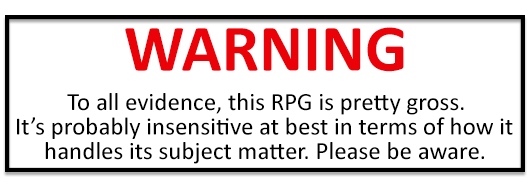
Oh no, not this shit again
Original SA post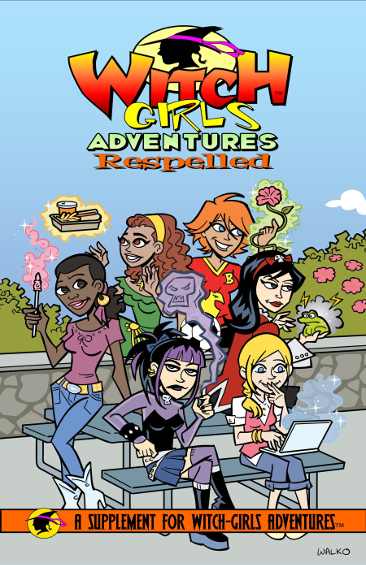
Malcolm Harris posted:
Nothing is perfect, We all make mistakes and despite everything nothing created is flawless.
Witch Girls Adventures is always growing and changing, through your feedback , convention demos and the various means we discover changes that need to be made and things we've forgot to add that needs to be added.
Most games would at this point release a new edition forcing you to spend you hard earned money on multiple books and basically buy the same thing over again. That's not how we do it.
Instead we release supplements and in this case a book that fixes our problems, adds to the game and doesn't force you to buy a full book.
So here we are, The book that turns Witch Girls Adventures 1.0 into WGA 1.5. Hopefully it'll do what we intended, help you run a better game and play in a better world.
Witch Girls Adventures: Respelled (or Witch Girls: Respelled depending on whether you go by the cover or the DrivethruRPG page) is the “2nd edition” of Witch Girls Adventures , an indie game for tween to teenage girls created by the barely functioning (and possibly law-skirting at this point) Channel M Publishing. WGA is a game where you play a (usually) tween witch who goes to magic school and does all the things that tweenage girls with near absolute control over the fabric of reality do. It was also written by someone with a transformation fetish and is based on stories from an old Geocities ezine for said fetish. Along with whatever stories the game’s creator, Malcolm Harris, and his unofficial partner-in-crime, Abigail “Abby” Soto, come up with when they need to get their rocks off, presumably.
Roughly 4 years ago, over the course of two previous FATAL & Friends threads, FourmyleCircus and I did write-ups of nearly all of the then available books published for the game. You can read those here , here , and here . If you don’t want to read all of those words (and aren't just reading these one after another on inklesspen's site) and have no idea what WGA ’s myriad problems are… well, you’re gonna have to for reasons that will become apparent soon. But here’s some cliff notes:
-
The mechanics, while serviceable, are wonky in some parts, broken in others, and occasionally make references to unused systems that were scrapped during development. (E.g. A D12+7 in a stat is considered worse than a D20. There are incidents of being forced to pick skill specialties with no mechanical system in place to compensate. Many skills are made useless by others that can be used for the same skill checks. The ranking system for spells goes up to 10, but any spell above Rank 6 effectively becomes GM fiat due to how overpowered everything is.)
-
The books tells readers to read supplement materials that were never released for information on some things.
-
Most of the NPCs in the core book were not stated using the same system used for PCs, resulting in them having powers that PCs can never have mechanically or completely outrank PCs of the same age and background by a ridiculous degree. (E.g. A 12 year old PC from the Sorceress clique gets 8 ranks to assign to her magic types. Lucinda Nightbane, a 12 year old NPC from the Sorceress clique, has 31.) Some of the said NPCs are also unusable because their sheets have unexplained elements from an older system in them or, in at least 2 cases, are just outright illegal to make.
-
Malcolm Harris couldn't pass an elementary school English class to save his life. The books are littered with grammar and punctuation errors and more than a handful of unfinished thoughts and sentences. The editors and proofreaders didn't do a damn thing to fix this beyond running the various Word documents that make up the books through spellcheck.
-
Characters in the default setting want, to quote a reply to a previous write-up, to literally “kill babies and be a saint at the same time”. (I’m not using “literally” wrong. There is a stated instance of this happening in canon.) Witches are given carte blanche by their government to kidnap, murder, and straight up abuse innocent humans as long as their doing so doesn’t cause whole countries to take notice and do something about it. They also routinely subjugate other magical beings and their governments and treat them like second class citizens... because they can, even while being vocally against the same social and political problems they have (e.g. non-universal suffrage, slavery, mistreatment of endangered animals etc.) in the mundane world and working behind the scenes to get rid of them. Almost none of the perpetrators suffer serious consequences for their actions and the game itself largely handwaves or ignores the hypocrisy and rampant corruption within witch society. This is all while the setting bemoans how humans are always persecuting witches for being different. Even NPCs who are said to be good-natured have moments where they flip out and either harm or threaten to harm someone via magic for petty slights. (It has been mentioned by people who have dealt with them that Harris and Soto have a poor grasp of the idea that actions can have negative consequences, and see such things as detrimental to a fun role-playing experience.)
- Princess Lucinda Hexxina Nightbane, Princess and High Enchantress of the Empire, and Lady of the Dark Isle of Corbus.
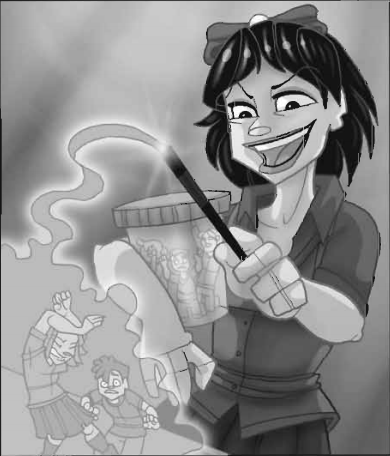
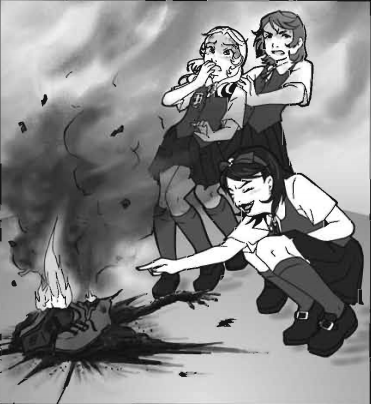
Back in March 2012, Channel M created a Kickstarter asking for $2,000 to make a second version of WGA , then titled Witch Girls: Book of Shadows . It succeeded and managed to raise $8,717 with nearly 170 backers. The book’s original release date was set for Halloween 2012… then March 2013… then a nebulous “when it’s ready”.
Months turned into years and eventually, Channel M’s original site went down and Harris went silent. Many of the book’s backers contacted Harris through email, Facebook, and Kickstarter about receiving a refund, only to get brushed off or ignored. At one point, Harris came back to announce that he was going to sue Disney for having a witch named Lucinda in one of their TV shows. Then went silent again when I assume it failed because no one outside of a niche sub-culture has heard of his and Soto's shitty character.
On March 26, 2015, the book, now with its current title, was released on DriveThruRPG and Lulu with no fanfare and no download codes for the backers. In the year that followed, Harris also released 10 supplement books for it. No, they weren’t offered to the backers. (He has offered to give people refunds, but from the looks of things, most people haven’t received them.)
So after four years and almost $9,000, what do we got?
Well for starters, as Harris himself points out in the quote above, the book is not a traditional standalone 2nd edition. I would describe it as a glorified errata book, since it is meant to be used in conjunction with the original core. Though it’s pretty much the core book with most of the setting fluff taken out of it (and in some cases, put into the supplements instead). So it could also be a 2nd ed core, I guess? (It also costs $10 as a PDF. Backers of the Kickstarter had to pay $20 to receive a PDF copy.)
(There’s also a “Director’s Cit” of the original core that doesn’t seem to be available anymore. I don’t know how much of it is identical to this book. (Though it seems like a lot of it is.) System Mastery has an episode on it if you want to know more.)
As you can probably guess, a lot of the stuff promised in the Kickstarter is not in the book. This includes the promises made about the intro comic.
quote:
Printing cost for a full color book: Like the original that would include a comic book style intro but instead of being ten pages, it’ll be 22 pages.
The comic is “The New Girl”, the 12 page continuation from the original WGA opening comic that Harris offered for free along with the first part on his Facebook one Free Comic Day several years ago. Unfortunately, that link doesn’t seem to work anymore. So here’s a summary.
(By the way, I came across this Tumblr post from “Phuong Hong Au Nguyen", the artist of this comic and the one in the WGA core. Apparently, Channel M were the ones who did the wonky lettering and were bad communicators all around.)
The comic picks up with Rosa Montoya arriving at Willow-Mistt. (Rosa, if you remember, is a late bloomer of a witch that the headmistress of Willow-Mistt sent the main NPCs cross country to pick up instead of an adult staff member because shut up.) Almost immediately after she sets foot on campus, the headmistress, Amora Mistt, pops the fuck out of nowhere and scares the shit out of her.
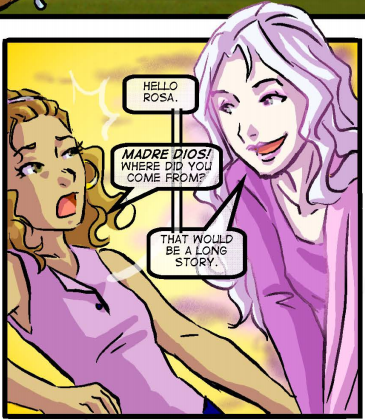
I assume she just came from her office.
Mistt acts coy and showoff-y as Rosa talks about believing magic and “brujas” were fairy tales and that the other girls made Mistt out to be a hellspawn demon. Mistt goes through the expected pleasantries and hopes that she will eventually feel at home at the school.
And just when you thought things were gonna be okay, Lucinda shows up.
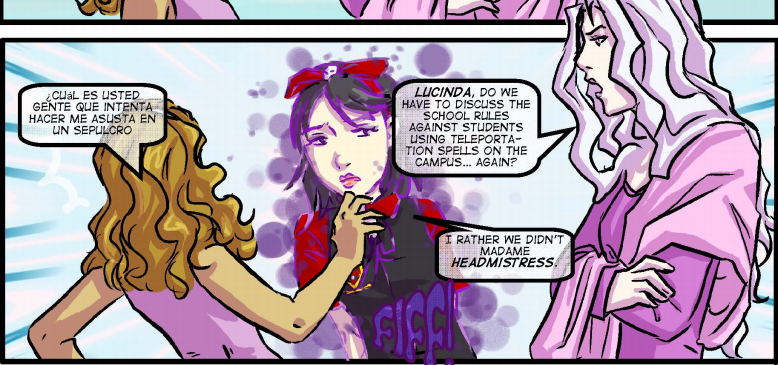
So teleporting around isn't allowed while all other forms of magic are apparently allowed on the front lawn.

I guess that unspoken rule from the core about not doing magic on the first floor of the main building, lest any mundanes show up and see it, doesn’t apply outside.
(My high school Spanish is incredibly rusty, but I’m going to guess that Spanish from Rosa has something wrong with it.)
Headmistress Mistt explains that, per school tradition, the last new student serves as the current new student’s guide. So Lucinda will be the one showing her around the school. What happens at the start of the school year when they presumably get a bunch of six-year-olds from magical families who know what’s up? Who knows.
She leaves Rosa at the mercy of Lucinda, who immediately gets pissed off over being told what to do.
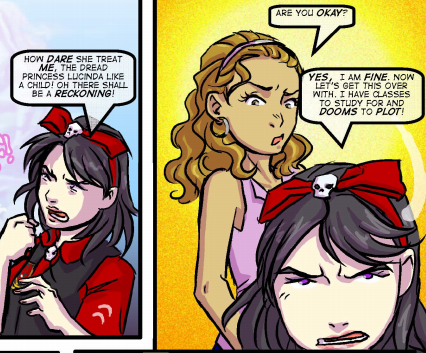
Yeah right, like you study. Your sheet says you’re better than most adults at magic.
She teleports them to Rosa’s dorm room, which turns out to also be the room of Circe Woodsworth, the Draco Malfoy of the school because Lucinda doesn’t actually fill that role on paper. Circe gets pissy because she was told she would have a room to herself that semester due to there being an odd number of students enrolled. Then gets pissy when Rosa tells her that she’s new to the whole magic thing. This allows Lucinda to explain the various Cliques.
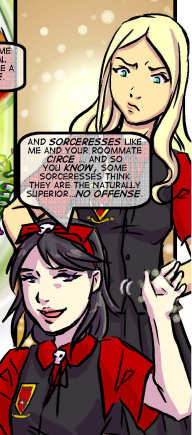
Circe confirms that she thinks she’s better than Rosa and chides Lucinda for hanging out with the riff-raff. (“And to think, I used to be ever so slightly envious of your position and power.”) Rosa tries to attack her and gets her bones turned into jelly, because we’ve gone 4 pages without someone getting mutilated by magic.
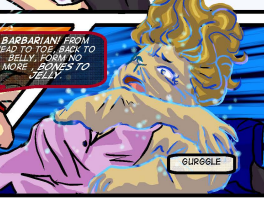
Lucinda demands that Circe change Rosa back, then does it herself when she refuses. It’s not because Rosa is her friend, you see, but because she made a promise to show her around the school, and Lucinda takes her promises seriously in this story. The fact that Rosa stood up for the little puke is a bonus too.
Then Lucinda turns Circe into a cigarette and smokes her, because Witch Girls .
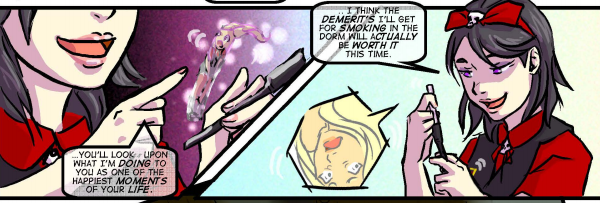
There’s a crash from outside. Lucinda and Rosa go to a window to see that someone fucked up a spell during a class and summoned a bunch of lesser flying monkeys. Lucinda wonders aloud how many students they’ll eat before the teachers step in. Rosa insists that they go out to help, but Lucinda finds the whole situation amusing. Plus, Rosa doesn’t know any magic. But she heads out anyway.
Outside, Amber, Amy, Lillian, and Monica fight the monkeys with various spells with stupid-sounding chants. Rosa makes up for her lack of magical knowledge by just trying to beat the shit out of them. Presumably realizing that Rosa might die during the fight, Lucinda comes out and turns the monkeys into snails and Circe into a legless pile of embers.
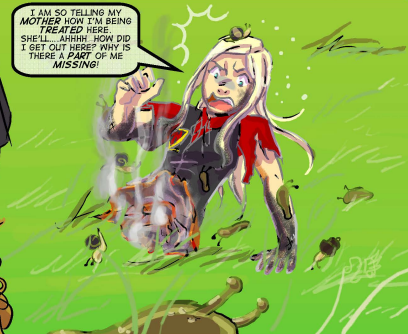
The fight over, Monica wonders why none of the teachers showed up to help them. It turns out the reason why was because they decided to teach the students a lesson about cleaning up their own messes. They even had a betting pool going to see who would deal with it.
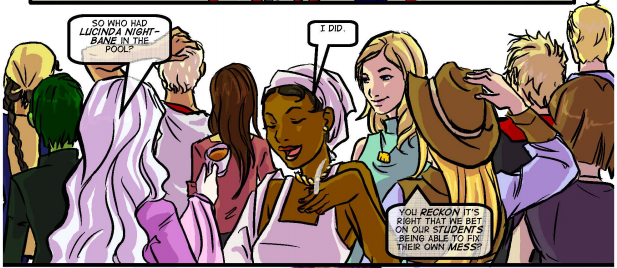
Remember that these monkeys are capable of killing the students, if Lucinda is to be believed. So in this case, no, Tandy. It's not.
Circe, now fully formed thanks to healing magic from Amber, threatens to get them all shipped off to the Dwarven cold iron mines and berates Lucinda again for her taste in allies. Lucinda says that she only calls the other girls her friends because it pisses Circe off. None of the other girls have a problem with this because that’s just how Lucinda do.
On the title page, Harris is credited for everything except for the art, playtesting, and the Assistant Editor position; a one Marcus Harris. He’s just as bad at editing as Emily Foster, who seems to have vanished from Channel M’s roster. Soto is still on art duty, but nearly all of the art is done by other people. So the book isn’t full of ugly traces of celebrities smashed together to look like witches murdering people. Which is nice. (Unfortunately, the same can’t be said for the supplements.)
Next: Rules
Gameplay Rules
Original SA post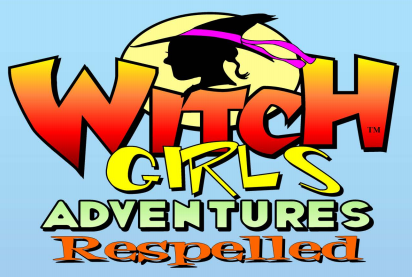
Witch Girls Adventures: Respelled: Part 2: Gameplay Rules
The book has six chapters, all of which deal with different mechanic systems. There’s no chapter opening bits of fluff. Though they do have a new chapter cover that I think looks kind of nice, compression artifacts aside.
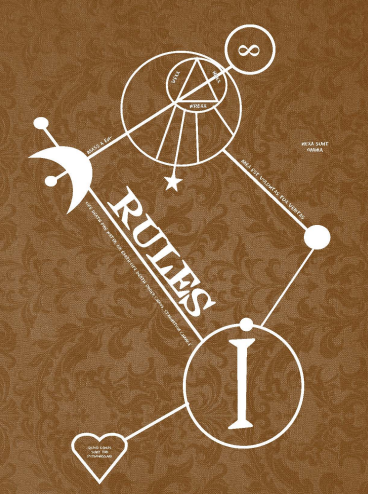
For your nitpicking convenience, the stuff written around the design (from the top going clockwise) is "Vexx, Hexx, Wrexx"; "Hexa Sunt Omnia"; "Mea Est Voluntas Tua Veritas"; "Quod Genus Sunt Tibi Pythonissam"; "Life Death Fire Water Air Earth Life Death Order Chaos Stagnation Change"; and "Mass X En-".
The first chapter goes over various gameplay rules. If you’re wondering why this chapter is first and not the stuff addressing character creation like in the first book, Harris explains it’s so they can save the “cool stuff” for later.
WGAR posted:
The rules of play have been altered and hopefully improved enough to a allow for easier entertaining play . Also we decided to do this first and save the cool things like improved cliques ad more for later.[sic]
With no setting and NPC sections in the back, I assume it’s also to make sure the book doesn’t end on a “boring” note.
First up: Skill checks. Skill checks are still made using the Attribute die + Skill rank pool. (Ties are a success.) But now there’s a new mechanic where if the maximum amount on a die is rolled and the check is still a failure, the player has a choice of spending either Zap points or a new mechanic called “Adventure Points” to buff up the roll result so that it does succeed. There seems to be no cap on what you can spend, so you can just burn the Zap as long as you’ve got it. Adventure points are not explained or brought up again.
The example given for this is someone with a D4 in Body and no points in the Fighting skill trying to punch a monster with a Reflex of 12. They roll a 4 and obviously, the check fails. With this new rule, that player can spend 8 of their Zap to make the roll a success. Standard starting characters, without stat modifications, have a Zap pool of 16. So this hypothetical player just spent half of their magic to succeed on a roll that, odds are, they would have just failed. The better option would have been just to get the physical character in the group to deal with it… or cast a spell, which they probably would have had an easier time doing. Not to mention with higher dies, this is less likely to come up as an option. (Though you probably won’t need it if you have a bigger die. Or, you know, are playing to your character’s strengths and not wasting actions in the hope of getting the chance to change a failed roll.)
Next is the Difficulty Ranks chart and Contested Rolls rules and chart. Both are unchanged. So I’m going to skip them.
Next is Combat. First is Surprise Rolls, which are the same save for the clarification that it’s a Hide roll versus the resisting character’s Senses. As before, it gives the surpriser a free action and the surprised a -2 penalty to combat rolls and spells.
Speaking of actions, new to the system is the Action attribute. This determines how many actions a character can take during a combat round. According to the book, most characters have one, but can gain more through athletic and combat skills. The book points the reader to the Appendix for more information. (Why is it not at the front where it’s being explained? Witch Girls .) There, it explains that the number of Actions a character has, like their Initiative, is determined by their Reflex stat.

Characters can hold actions and go later in the Initiative list with the caveats that they use all of their actions before the end of the combat round and that they go after characters who are taking their actions normally. (e.g. Someone who has Reflex 7 gets to go before someone who decides to go on 7. A character with Reflex 15 with 3 Actions can go at 15, 13, and 9 if they so choose.)
Back at the front of book is a list of things that are considered Actions, which are pretty much the same from the previous version. Unlike the previous version (where you got one attack and one non-attack), there’s only one type of Action. So skill rolls, moving, and talking all draw from the same Action point pool as physical attacks, casting, and preparing spells (which gives you a +1 to the Casting roll). So if you’ve only got one Action point and you want to taunt someone during combat, you’ve got to make a choice, my friend.
Casting more than one spell in a combat scene also adds a cumulative penalty to each additional spell roll. (-1 for the second spell, -2 for the third, and so on.) I want to say that that’s a typo and Harris meant “round”, but who knows.
I also can’t really make out the rules for Move actions, which are copy/pasted from the original.
WGAR posted:
Move: A character can move 20 ft in a scene on foot, 10 ft in a scene in water, and 50 ft in a scene per calculated 100 mph of flight.
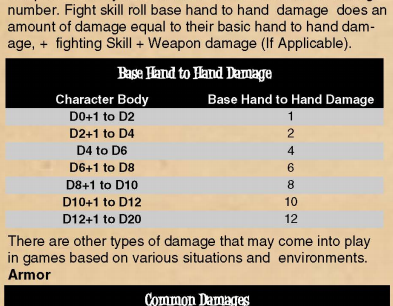
There’s nothing about armor under that bolded armor. It’s after that damage chart which, aside for the first part about unarmed damage, a note that every 3 ranks of Fighting adds +1 to damage dealt (instead of a static +2) and the exclusion of how much damage being unprotected in outer space does, is also copy/pasted from the original, typos and all. (But how will I know how quickly launching Lucinda into space will kill her in this new version?!)
In Armor news: Immortals now have 5 points of natural armor instead of “1 to 2”, and there is now a chart for various types of armor.
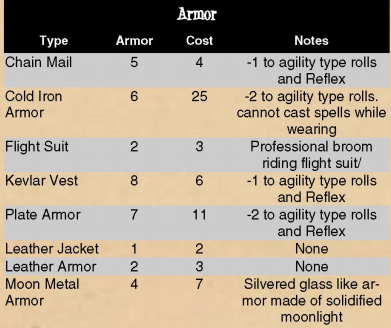
Also new is non-lethal combat. If you want to knock someone out without killing them, have the target make a Body + Armor vs Damage taken roll. The first successful attack staggers them and gives them a -1 penalty to rolls. The second increases the penalty to -2. The third knocks them out for a D4 roll's worth of combat rounds or minutes if knocking them out will end combat. While knocked out, the only thing a target can do is roll to resist damage. Knocked out characters can wake up with a Hard Tough (which is a talent, not a skill) or Will roll, or an Easy one if they can regenerate.
The section on life points begins with a small blurb pointing out that the rules were changed to help make more detailed Immortals in supplements. There’s no supplement dedicated to Immortals yet. (Though there are a couple of character sheets for Immortals scattered about. Though at least one of the supplement books I have was written with the old rules in mind. As much as characters who are made outside of the character creation rules can be. So...
 )
)
Humans no longer straight up die when they hit 0 Life and can roll (Hard Body) to stabilize themselves like the supernaturals can. Instead of lowering the Body die, all characters just die if they are not stabilized in 3 rounds. Any additional damage that penetrates their armor while they’re down will kill them. Along with an ally healing them and the Body roll, witches and other otherkin now have the option of spending 5 Zap points to stabilize themselves. Once stabilized, a character can roll to resist damage. No telling if any damage getting through still kills them though.
At the end of combat rounds, everyone involved regains a life point. Instead of being tied to the Body die, mortals and the different otherkin all have separate rolls when regaining life points while resting.
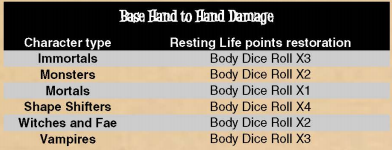
Characters with the First Aid skill can make a Difficult skill check to heal themselves and others out of combat. This heals a D4 roll’s worth of health. Healing rates are still doubled when a character is receiving medical care.
New with inanimate objects, any object that takes its life points or more in damage from one attack is considered “Devastated” and is damaged beyond repair. Then it shows the Inanimate Object Armor chart from the core.
Next is flight rules. You still need the same rolls to fly. The rolls chart for doing different maneuvers is the same one from the core. The rules are completely copy/pasted from the core. Moving on…
Experience points are still represented and given out as voodollars. Most of this section is, again, copied word-for-word, with typos, from the original book. The only differences are that the recommended number of voodollars per player per episode has been lowered from 15 to 10, and some entries on the purchase chart (which no longer has the wrong title) have been changed. The required amount of dollars for purchases have been, on a whole, significantly lowered.
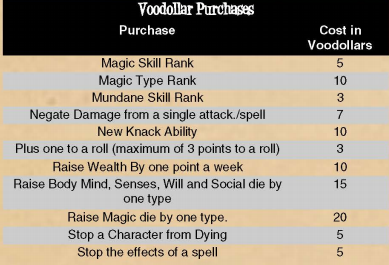
The book stresses, however, that All About the Voodollars is still the definitive source for all things voodollars. So if you still want to force your players to make Witch Girls blogs and fansites, you still have a suggested voodollar amount you can pay them. (And presumably potions still cost around $600 for three doses in-verse.)
And that’s it for this chapter. There isn’t a lot of art in this book, and some of it is just reused pictures from the core (in color). So there won’t be much material for a horrible picture round-up. Occasionally, however, the book does sneak in a new piece of someone transforming someone. You can probably guess who is featured in them.
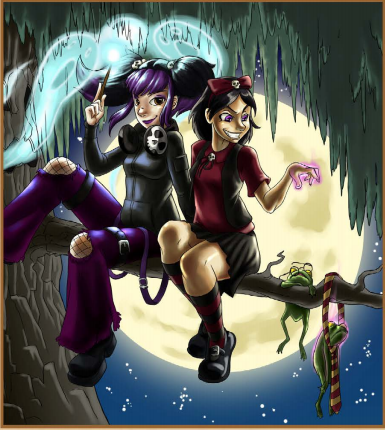
Next: Character Creation
Character Creation
Original SA post
Witch Girls Adventures: Respelled: Part 3: Character Creation
I hope you weren’t waiting for the rules on how to play something other than a witch like the Kickstarter promises. There’s nothing of the sort in this book.
You’re probably also wondering by now if Harris fixed that whole “a D12+7 in an attribute is worse than a D20” thing.
No. No, he didn’t.
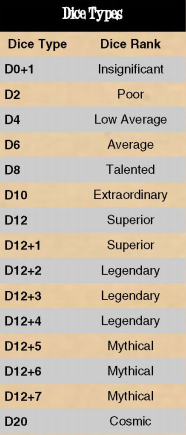
Attributes, both primary and secondary, are unchanged. (Save for the mentioned addition of Reflex determining how many Actions per round a character gets. Actions is considered a secondary attribute.) As is how many points can be allocated to skills and magic ranks. (No more than 6 and no more than 3 (unless you have a clique bonus), respectively, for a standard character.) If you’re assuming their descriptions have been copy/pasted from the other book, you are right.
The 5 original Cliques are still available. However, Respelled introduces, by “popular demand”, a brand new Clique: Techies . Techies are exactly what they sound like: Witches who are really into mundane technology and adding magic to it. However, as you’ll see in a bit, the book portrays them as being more fandom/Internet nerds than technology nerds. So now we have witches who have spent most of their lives in the mundane world, ones who spent their lives in the magical world, ones that have spent it in both, country folk, goths, and fandom weirdos.
(Monica, if you care, is now considered a Techie. Her picture is used on the page for it.)
All cliques now have the same starting pool of dice to assign to their attributes: a D4, a D8, three D6s, with a D8 for Magic. Starting skill points have increased all across the board: Gothiques, Rustics, and Sorceresses get 15 Mundane and 15 Magical; Insiders and Techies 20/15; and Outsiders 25/10. Starting magic ranks have been bumped up to 10 for most cliques, with Sorceresses getting 12 and Outsiders getting 8.
Each clique now gets two bonuses instead of one. Sometimes three.
Gothique: A free rank in either Curse or Necromancy and +1 bonus to rolls and damage when dealing with ghosts and the undead.
Insider: A free rank in two mundane skills (up from one), a free rank in Mysticism, and the ability to instantly tell if someone is a supernatural.
Outsider: +1 to all rolls when dealing with mundanes and +1 die type to any of their primary attributes except Magic.
Rustic: A free rank in Elementalism or Divination and 2 free ranks of Survival, which doesn’t exist, and Track.
Sorceress: +1 to all rolls dealing with non-mundanes, 2 ranks in Cryptozoology and Mysticism, and 1 free rank in Casting. (No, no free ranks in Alteration!) I don’t think the skill rank choices (aside for Casting) fits all that well.
Techie: Two ranks in Build/Repair and Computer and the ability to talk to machines. (No, no free rank in Cybermancy.)
Another big change to the character creation rules is the addition of an optional feature called Niches . Niches are basically character ideas with point bonuses tied to them. Each clique has 5 niches. Starting characters can only pick one and can’t gain more.
Gothiques:
Creep Out: The character is creepy and no one likes being around them. Can spend 1 Zap to give people -1 to their rolls for a minute out of combat and for an entire combat scene, at the cost of -2 to all of the character’s rolls.
Eclectic: Learned how to do magic from reading comics, researching UFOs, and other weird shit like that. It doesn’t specifically make reference to Harry Potter , but I imagine learning magic through that is one of the things you can do with this Niche. -1 Resist to witches you cast spells on and a free rank in Mythology and Pop Culture.
Princess of Darkness: The character fucking loves Necromancy and dealing with dead stuff. +1 to manipulating and controlling the undead, vampires (doesn’t say if half-vampires count) and ghosts. -2 penalty to all undead dealing with the characters.
Rebel: A loose cannon who don’t play by anyone’s rules… except maybe the weird subculture’s they subscribe to because you know how kids are. Can spend a Zap to remove any spells controlling you, and +1 to rolls when standing up to authority.’
Shadow Mistress: The character fucking loves Necromancy and dealing with shadows. +1 to attributes and rolls to deal with shadows and darkness and the ability to see in total darkness.
Insider:
Bridge between Worlds: The character has a room that can connect to another place in the magical world. The location of the connecting doors can be changed once a week for 5 Zap.
Diplomat: +2 to rolls when leading mundanes and otherkin and trying to get them to cooperate, and 1 free rank in the Charm and Leader skills.
Personal MAC: AKA “Secret Keeper” due to non-editing. They have a naturally occurring Mundane Avoidance Charm on them that gives a -2 penalty to people trying to figure out if the magical fuckery going on around them is the character’s fault.
Strange Relations: Call for help from family members with a skill roll. Which skill? Use your imagination. They get a +5 to the skill roll.
Spy: The character is a spy for the Witches World Council tasked with keeping an eye on either the Argus Society, Project Stormwall, or witchspiracy.com. (Keep in mind that last one is run by one paranoid guy in Seattle that no one takes seriously.) 1 free rank in Mundane Athletics (or rather, just Athletics), Etiquette (or rather, Mundane Etiquette), and Hide (which has had a name change).
Outsider:
Blind Luck: Spend 2 Zap to add +1 to any roll, but only if that bonus will make the roll a success. Lame.
Elite Born: The character comes from a family of humans whose stats are slightly less shitty when compared to other humans. Not from a family of rich and/or influential people like the name would imply. +1 to their Body and Mine dies.
Heroine: Can give themselves a bonus on any Body die roll; up to +3 max, by spending Zap.
Metamor-force: The character is a magical girl. They don’t say that exactly, but that’s what this niche turns your character into. Character creation makes their magical form. Their human form has D6 Magic and can’t use their magical skills, but others have a -2 to identify them as magical and they have their normal Resist Magic attribute for resisting spells.
Savant: The character is self-taught and didn’t use UFO articles or copies of Harry Potter to learn how to use magic. Can use an attribute other than Magic for Casting rolls and calculating their Resist Magic. This is the basis for System Mastery ’s infamous “Punch Witch” build. So remember: if you want to make a little witch Saitama, follow these instructions:
-
Take this niche
-
Put your biggest die in Body
-
Put your free die boost in Body
-
Take the Half-Immortal heritage
- Take the Jock talent.
Rustic:
Archer: The character can put spells on arrows, making them unblockable, undodgeable, and use Reflex as the stat for resisting the spell. At the cost of an extra Zap point to the spell. This is apparently something few witches are capable of doing.
Feral: Spend 2 Zap to enter Feral Mode. Feral Mode gives the character +1 to Body and Senses rolls and +2 damage to scratching and biting attacks.
Demeter: Immunity to plant-based poisons and the ability to regain a Zap point from plants over 3 feet tall.
Rugged: Can give themselves up to a +6 bonus on Body based rolls at a rate of 2 Zap for every point.
Storm Singer: Strom Singers can call a slight breeze with a Zap point, gain +1 to all of their rolls during natural storms, and know when storms are coming. I was sort of expecting a rip-off of Storm from X-Men .
Sorceress:
Interestingly, none of the niches for this clique involve Alteration. I think at some point while writing this Harris got the hint that mentioning and showing people getting turned into shit constantly made people suspicious. But don’t worry, there’s still the supplements…
Combat Witch: +1 to Casting when dueling with another witch and +2 to rolls to block and dispel spells during regular combat.
Floater: The character is always flying. Because their feet are almost always a few inches off the ground, they don’t taking falling damage and only take half if they’re forced to the ground. (If you all can fly, what’s the point of having brooms?)
Forbidden Knowledge: A free rank in Leyology, Naming (which doesn’t exist), Rites, and Mysticism. +1 to rolls for discovering magical traps and new magical knowledge.
Merchant: +1 to rolls to find out information about happenings in the magical world, and all purchases cost 1 Wealth rank less. (Can’t be lowered to 0.)
Royal: Can spend up to 3 Zap to add a +1 (+3 max) bonus to their social rolls.
Techie:
Cosplayer: Can spend a Zap to make their aura appear as another type of being’s and gain the appropriate outfit to match.
Cyber Star: +1 to spells cast on computers and can spend a Zap to use the Computer skill in place of the Casting skill for a roll. Does not make the character an internet celebrity like the name would imply.
Gamer: A free rank in Games, +1 to rolls and damage dealt when “using tactics”, and “can use a Power up from Equipment-Computers for free” once a day. I assume by “Power Up” it means “Add-Ons”, which are a feature detailed in the Equipment section.
Larper: A free rank of Fighting and a magic weapon that costs 5 points or less. The niche explains that they get these because they are “trained” LARPers. Obviously, it’s talking about boffer LARP and not White Wolf style “have real life meltdowns over fake politics and try to get laid” LARP.
Steampunker: Can declare any equipment they have to be “steampunk”, which makes it unusable to everyone but themselves and other steampunkers. So if you want to be cheeky, just slap a bronze-colored gear on everything you buy. Now no one can use it.
The next section details the brand new Class system.
WGAR posted:
Class replaces the wealth concept with Wealth.
Class, along with the associated Wealth stat, expands on the Allowance system from the core and allows it to be used with adult characters. It also gives a better idea of the kind of lifestyle a character has outside of school. Along with determining a character’s starting wealth (and in turn, how much starting equipment they can buy), different classes also give different stat and roll bonuses. So yes, while there is nothing stopping you from doing so, there is some incentive to make your character something other than the magical spawn of the 1%.
There are six classes: Vagabond, From the Block, Country Girl, City Slicker, Well-to-do, and Rich; from lowest wealth (1/10) to highest (5/50). Country Girl and City Slicker have the same wealth. (2/20)
For bonuses, we have…
Vagabond and From the Block : +2 Life, +1 Reflex, a free rank in three (two for FTB) of either Fighting, Hide, Streetwise, or Urchin.
Country Girl: +2 to Life and Zap and a free rank in two of either Fighting, Track, Herbalism, or Cryptozoology.
City Slicker: +1 to Life and Zap and a free rank in two mundane skills.
Well-to-do: A free rank in two Social skills.
Rich: 2 free ranks in either Charm or Mundane Etiquette.
Last for this chapter is the optional character age rules. There are now rules for playing characters anywhere from ages 6 to 22. It also fixes the issue from the core where the cap on Magic ranks didn’t scale with a character’s age. (They increase and decrease by 1 with each age group. So a starting 18 to 22 year old can have up to 5 in a Magic type.) Older characters are also able to take more Talents, Heritages, and Knacks (a new stat) at creation. Skill ranks and die types (one for each step) are increased or decreased depending on the age range.
Next: Skills
Skills
Original SA post
Witch Girls Adventures: Respelled: Part 4: Skills
WGAR posted:
Skills received a large enough overhaul to require a near complete rewrite.
Most of the Skills chapter is copied word-for-word from the original book. There’s even still a line pointing readers to the Director 101 section, which doesn’t exist in this version. Surprise surprise.
The basic rules for skills are still the same: Skill ranks can go from 0 to 10. There are separate pools of points for Mundane and Magical skills. You can only put a maximum of 6 in any given skill at character creation. (7 if you have a bonus from your clique and niche.) Every skill’s got an attribute die associated with it that is used for skill checks.
Rolling for skills that you don’t have ranks in now requires you to make a Mind + Basics roll with a -2 penalty instead of whatever skill the roll is for. (The original version made you do the original roll with a -1 penalty.) To make it even less likely that you’ll have to do a roll with a 0, all characters automatically get 3 ranks of Basics for free at character creation. Along with a free rank of Casting. So disregard the example for the Maximum Roll rule at the start because even that gets the math wrong.
 You can’t do this for magical skill checks. There isn't even a separate rule for doing it with those skills.
You can’t do this for magical skill checks. There isn't even a separate rule for doing it with those skills.
There are a couple of changes to mundane skills. “Fix-Electronic”, “Fix-Mechanical”, “Garden”, “Hear”, and “Look” are gone. “Build/Repair”, “Charm”, “Hiding” (renamed from “Hide”), “Investigate”, “Languages”, and “Riding” are new. Some skills have also had tiny tweaks to their stat bonuses. Most of these come in the form of clarifying that any skill that gives a bonus to stat gives it at a rate of 1 for every 3 ranks in the skill.
Build/Repair: Ranks in this skill let you build and repair FUCKING EVERYTHING; from electronics to houses to planes to whatever that doesn’t involve magic and isn’t a computer. (Those are covered under the Computer skill.) Characters can take a specialization in this that gives them a +1 to build and repair that specific type of thing while getting a -1 to all other things. Thankfully, the wording makes this out to be an optional thing. So feel free to not use it and be an omnicrafter.
Under the skill explanation is the rules for building and repairing items. The difficulty and time needed to build an object is based on its cost. Here, have a chart.
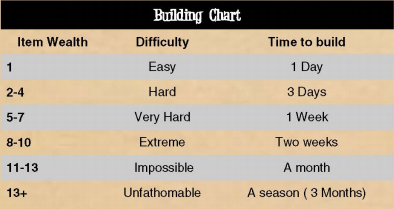
The cost to build an item is half its cost “if purchased of a shelf”.
The difficulty of repairing an item is also determined by a difficulty roll.
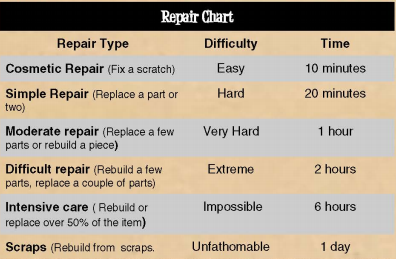
I would think rebuilding something from near scratch would require more than a day. Also, wouldn’t that count as being “devastated”?
You can also decrease the time needed to build or repair something by making a higher difficulty roll. The example given is making a Hard item completable in 1 day by making a Very Hard roll.
WGAR posted:
Failing a Build Repair rolls means the Build or repair fails.
Thanks, WGA. I never would’ve figured that.
Failure also means that half of the materials used are rendered useless.
Charm: A Social skill; the ability to use charisma to control and negotiate your way into getting people on your side. Resisted with Will. The book points out that this isn’t the same as using Mentalism to just mind control people, in case you are an idiot and confusing the two. Charming groups is done by making a difficulty roll of Hard or higher.
Computers: Pretty much the same as before (in that if you can use an operating system, you can also build websites and hack the Gibson), except now there’s a new set of rules on hacking computers and servers.
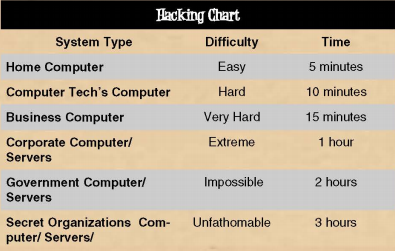
(Hacking a government computer is listed as one of the examples for Extreme on the normal difficulty chart back in the first chapter. So which is it, Harris?)
Naturally, this chart doesn’t account for human error or the idiot companies that still have “password” as their network password. I guess witchspiracy.com also has excellent security.
Making a hacking roll at a higher difficulty from what it would normally be also decreases the time needed to complete the hack. Failure allows the DM the option of planting a virus or making the character traceable.
Fighting: Along with granting a +1 damage for every 2 ranks, characters with ranks in Fighting also now get a +1 to Life points and Reflex for every 3 ranks they have. A system for combat maneuvers has also been added to the system.
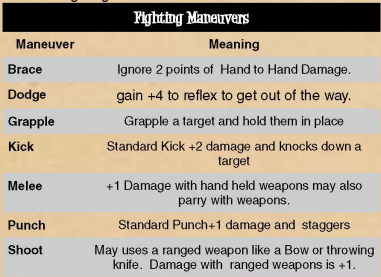
Using individual maneuvers costs an Action point each. Some also grant minor abilities if they land. Most of the ones that do are not on the chart.
Grappling: The target can't move. Requires either a Grapple vs Grapple or Body vs Grapple if they have no points in Fighting. The wording makes it sound like Grappling is a separate skill you can put points in. There's no mention of having to put points in the separate maneuvers to be able to use them.
Knockdown: Target has to spend an Action to get back up.
Parry: No damage is taken from an attack. Can be used for arrows as well as hand-held and thrown weapons. (Unless it’s an arrow with a spell on it. Then you’re SOL, I guess.)
Stagger: Target takes a -1 to their next roll.
First Aid: Different medical maneuvers and their difficulties now have a chart dedicated to them.
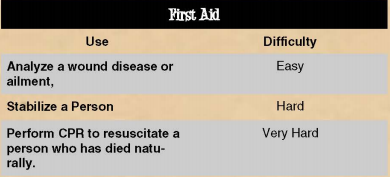
Investigate: A Senses skill used to analyze information about people and places. Difficulty ratings are given to the clues and pieces of information to be deciphered.
Hide: According to the blurb, this is still resisted with the Hearing and Look skills. Both, according to the chart at the top of the chapter, no longer exist.
Languages: Every rank in this skill makes you fluent in one language. In addition to regular languages, you can also take a host of new otherkin based ones. The ones given are Dragoon (spoken by dragons
 ), Pix (fae
), Pix (fae

 ), Runic (giants and dwarves), Thul (vampires and creatures of shadow), and Whyck (“the ancient language of witches”).
), Runic (giants and dwarves), Thul (vampires and creatures of shadow), and Whyck (“the ancient language of witches”).
Look: Despite supposedly no longer existing, its blurb is still in the book.
Riding: A Body skill that covers maneuvering and staying on mundane horses, donkeys, and the like. I guess all of those endangered unicorns that witches use fall under another skill. Resisted with Will.
In magical skills, “Broom Riding”, “Magical Etiquette”, and “Spell Breaker” have been replaced with “Flying”, “Leyology”, and “Rites”.
Casting: Spell Breaker is now a part of the Casting skill which, like Fighting, now has a bunch of sub-Actions.
Detect Magic: Make a Senses roll to detect magic and magical beings within 10 feet, or 20 at the cost of a Zap point.
Prep a Spell: Spend 2 Zap to cast a spell as if it were one magic rank higher.
Spell Breaker: Casting vs Casting result. Win and you fuck up a person’s spell.
Cryptozoology: The Social roll bonus has been removed. However, if you make a Hard Crypto roll during combat, you can do +2 damage and ignore 3 points of their armor.
Enchantment: Build/Repair for magical items. Uses the same rules.
Flying: Same as Broom Flying from the core.
Focus: Also has a chart associated with it now.
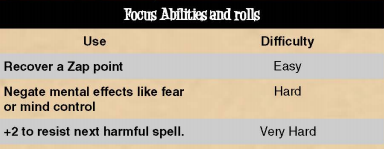
Herbalism: An added bonus of +1 to any Casting roll for spells that involve plants in some way.
Leyology: A Mind skill; the study of ley lines and magical places. With this new skill comes a list of the different types of magical places.
Dead Zone: There ain’t no magic in these places. Spells might not work. Creatures that rely on magic to live stop existing. -4 to all magical skill rolls, regenerating isn’t allowed, and Zap pools are halved.
Haunting: Places with spooky ghosts in them. +1 Casting bonus and -1 Zap cost to all Necromancy rolls and ghosts get +1 to their Body die and all of their rolls.
Minor Place of Magic: Magical towns and constructs usually fall into this category. +1 to Casting rolls.
Major Place of Magic: Places that are fed by many ley lines and produce their own magical energy. Useful for rites. Usually regulated by the Witches World Council. +2 to Casting, +1 to Magic die types, -2 to spell costs, and…
WGAR posted:
spells that would normally cost 0 zap points no longer cost 1 zap point but instead cost zero zap points.
Potions: Now gives +1 to rolls to resist the negative effects of potions.
Rites: The ability to organize and cast group spells. This is rolled in place of Casting when used.
All rites are led by an appointed leader, whose magical knowledge limits what spells can be cast. Leaders always make the first roll of a rite, and if they fail it, the others can’t make their rolls. If any of the other characters’ rolls fail, the whole rite fails.
The difficulty of their individual rolls is determined by the action that they’re trying to do. This can be lowering the cost of the spell by 1 (Easy); adding a rank to the spell’s range, size, or defense (Hard); or adding a rank to its duration, number of targets, or damage (Very Hard). A rite’s spell cost is basically whatever the spell would normally cost, with the Zap cost divided up among everyone.
The time it takes to do a rite is determined by the spell’s magic rank.
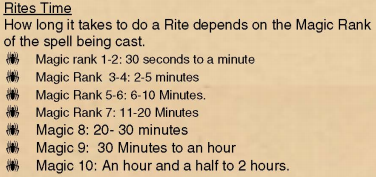
And that’s it for skills. Have another new picture.
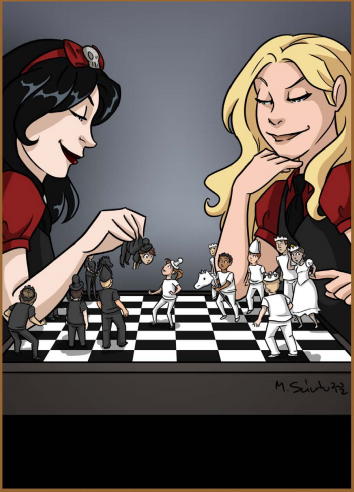
Of course Lucinda and Circe will play chess together despite hating each other's guts. Consistency in characterization is optional in the WGAverse.
Next: Traits
(By the way, here's the other commissioned artist that I found. The one that didn't get paid in full.)
Traits
Original SA post
Witch Girls Adventures: Respelled: Part 5: Traits
The Traits chapter starts off with a list of all the different types of advantages they can give a character. One of them is this:
WGAR posted:
Attribute Bonus: A bonus to an attribute making it one die higher (still cannot exceed D12).
Now in a better game, this would probably put a damper on the Punch Witch build. (Though a D12 is still pretty good.) However, another explanation in the same section uses changing a die to a D12+2 as an example. So… use whatever rule you like if you find yourself playing this, I guess.
Anyway…
WGAR posted:
What makes a character unique more than anything else is her Traits. The original traits offered unique roll and role-playing aspects that fans loved and we're trying to improve here.
Traits work pretty much the same way they did in the original: standard characters get 2 Talents and 1 Heritage, which give them bonuses and penalties to different things as well as give the character's character traits. The biggest changes are that Talents can no longer be bought with EXP after creation, Heritages, for the most part, no longer give disadvantages, and there is now a new trait called Knacks. More on those when we get to them.
The only major changes to the Talents list is that “Rich”, due to the new Class system, is now gone, and there are two new ones: “Sassy” and “Witty”. A bunch of talents also have additional bonuses on top of or in place of the ones they have in the core. Actually, traits on a whole have had more of an overhaul than skills have. I don’t know why the rewrite mention isn’t in the little blurb for this section. Though I've noticed that the design goal for Traits seems to have been “make everything more powerful”.
Brave: Now gives a +1 to all rolls when the character is up against enemies more powerful than them. You still don’t have to really declare what kind of spells you’re scared of. So you can just say “everything” and always get the bonuses.
Calm: Now gets a free rank of Focus.
Creepy: Gives a -1 penalty to “weaker characters” when they roll against the character. What is considered weaker? Who knows.
Devious: A free rank in Liar, which doesn’t exist. Presumably, it means “Fib”.
Drama Queen: A free rank in Acting.
Eccentric: +1 to resist Illusion spells for… some reason.
Entertainer: Instead of a +1 to performing rolls, they get a free rank to either Acting, Instrument, or Singing, and can cast spells with a musical instrument or by singing. This costs a Zap and increases the MTR of the spell by 1.
Friendly: The bonus for inspiring someone has increased to +2.
Geek: Instead of the bonus to dealing to geek stuff, you get a free rank in Science or Pop Culture and “+1 to a roll in a situation that resembles one that appears in comic book or si-fi [sic]/ fantasy movie, game, or book." Considering this whole setting is based on a comic book…
Goody-Goody +1 to resist harmful spells.
Gloomy: The weirdly worded bonus/penalty has been increased to -2.
Green Thumb: The First Aid bonus is gone and has been replaced with a +1 to resist… stuff when dealing with plants.
Jaded: +1 to resist harmful spells that have been used on them in the last 24 hours.
Lackey: In addition to the other bonus, lackeys can take an action to take a hit for someone in the party within 20 feet of them.
Mary Sue: Instead of the old bonus, Mary Sues can now gain 3 ranks in a skill they don’t have once a day and spend a Zap to gain a +1 to any die except Magic for an hour. Definitely fits better than its old bonus. Unfortunately, it still seems to be applied to characters who are just massive narcissists and not, say, capable of murdering people seconds after their birth and getting away with murder every goddamn day of their lives and still have people who actually want to be their friend because they like them and not because they’re terrified of what will happen to them and their families if they don’t…
Meek: A free rank in Hiding plus the old bonus.
Mysterious: The old bonus has been done away with in favor of a +1 to resist any rolls from someone trying to figure out anything about them, and can spend a zap to make people forget a bit of information about them. So if they succeed on the first roll, use the second option.
Queen Bee: A free rank in Leader and the ability to summon a Rank 1 NPC for an hour.
Ruffian: A free rank to Urchin and Streetwise.
Rural: Can now ignore penalties caused by rough terrain or weather along with the original bonus.
Sassy: Your character is the embodiment of
 . There’s even a picture of Amber under the description to drive this point home. They can spend a zap to draw attention to themselves. This can be used to either give themselves a +1 to Social rolls or to make enemies target them on their next turn in combat. Ever wanted to tank enemies by sassing at them? Here you go.
. There’s even a picture of Amber under the description to drive this point home. They can spend a zap to draw attention to themselves. This can be used to either give themselves a +1 to Social rolls or to make enemies target them on their next turn in combat. Ever wanted to tank enemies by sassing at them? Here you go.
Temper: Can now spend a zap to gain +1 to rolls and damage while they beat the fuck out of whoever pissed them off. They also ignore a point of damage when doing so.
Tinkerer: A free rank in either Build/Repair or Enchantment. Building and repairing times are halved.
Tough: +1 to Resist Magic and the character always ignores 2 points of damage.
Trickster: Can ignore a harmful spell, harmful effect, or attack once per day along with the original bonus.
Urban: Can spend a zap to know the location of any building in any city.
Warrior: Can ignore a point of armor, a free rank in Fighting, and +1 to unarmed melee damage.
Wicked: Along with the original bonus, all of their spells are treated as being 1 magic type rank higher in either their range, duration, or damage when they’re using them to be an asshole to others.
Witty: This type of character always has a comeback or quip at the ready. They get a free rank of Charm, which they can also use once per target per day to make up a joke or insult with a Hard difficulty roll. Jokes give “+1Life Points of Zap points” while insults give a -1 to rolls.
Zap Happy: Can now instantly gain a zap point once per day on top of their other bonus.
The Heritages list has gotten 9 new entries: “Alchemist”, “Amazon”, “Crystal Gazer”, “Dreamer”, “Elementalist”, “Godmother”, “Martial Artist”, “Melodious”, and “Summoner”. "Attuned" is now "Arcane Aptitude". "Zappy Fingers" is now "Zapper". “Hex Breaker”, “Mystic Void”, and “Twitch Witch” are gone. While heritages no longer give disadvantages on a whole, some still do come with minor ones. (Which are shoved in-between the Advantage bullet points in the book.)
Alchemist: Pretty much the Alchemist heritage from All About the Voodollars, right down to some of the wording being the same. They get 2 free ranks of Herbalism along with the ones for Potions and the ability to bottle and throw spells at people; can identify a potion by smell, taste, or color with an Easy roll; can add an additional dose to every potion they make (or as the book puts it “all Potions a Potion make…”); can change the resist attribute of a potion with an Easy roll and D12 minutes of work; can combine two potions into one with a Hard roll, and can alter a potion when it’s made to look like another. Those are all under 3 bullet points, by the way.
Amazon: The character is a member of a group of misandrist
Arcane Aptitude: “Arcane Aptitude to the forces of magic” among other things that basically say “you can use your energy to do magic”. Can spend a zap to add +1 to mundane skill rolls; 2 zap to add +1 to magical rolls or their Resist Magic; and can spend a zap to add a rank to a spell’s range, duration, or damage.
Crystal Gazer: The character uses crystals in their spellcasting. No, not crystal balls. These crystals cannot be purchased and must be found and processed. They start the game with a crystal wand (a standard wand with +1 to rolls to find crystals), a large crystal, and 3 small ones. They get +2 to skill rolls involving crystals, can store spells and zap (which an ally can use) in their crystals, get +1 to the duration of Divination spells, and restore +2 health with Healing spells.
Conjurer: The free rank is gone, but the size and duration of spells is one rank higher, spells cost a zap less, and they gain a +2 Casting to mess with other Conjuration spells.
Dreamer: The character has the ability to enter and control dreams. Can spend a zap to get a full night’s rest (with dreams, natch), can spend 2 zap to give a person nightmares (and a -1 penalty to all rolls the next day), and can spend 5 zap to summon a Guardian. To enter and mess with people’s dreams, they spend a zap and have to succeed a Will vs Will roll. To change dreams and communicate with the dreamer, they need to succeed on a Hard Will roll.
Elementalist: The character has an affinity with one of the classical elements, Light, or Dark. +1 to spells based on their chosen element, ignore 2 points of damage from the element, can do an attack for 2 zap that causes 10 damage and can go up to 50 feet, and can spend a zap to travel up to 50 mph for an hour using the element.
Evil Eye: They can still fire rainbow beams from their eyes to cast spells, but the Senses boost is gone and they take a -2 penalty to their starting zap pool. Their beam spells have +1 range and they can spend a zap to use their eye beams as a normal attack. (Which does 5 damage or gives a -2 to Resist for an hour. It has a magic type rank of 3.)
Godmother: Doesn’t have a blurb. So use your imagination.
Hag’s Syndrome: Characters with Hag’s Syndrome now no longer need to eat or drink and don’t take damage from water because reasons. They get +1 to Magic and a +2 to resist Alteration spells. The other benefits have been removed.
Half-Otherkin: Here, have a cute picture of a catgirl.
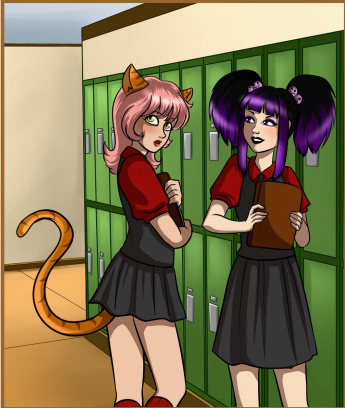
No, you can’t play a catgirl. The four choices for this heritage are still the same. (“Dwitches” from Voodollars weren’t brought over with the Alchemist heritage.)
Fae: Everything but the bonus to Illusion magic is still around. As is the weakness to iron and “still”. (+2 damage. What happens when they’re binded in it isn’t mentioned.) They can also spend 2 zap to instantly teleport up to 20 feet away.
Immortal: Still have doubled speed and +1 to their Body die. But they now heal twice as fast, ignore 3 points of damage, and must make a Hard Will roll to break an oath or lie.
Werewolf: They still get a bonus to their Senses die and can turn into a wolf. The bonus to Body rolls is gone. They regain health at a rate 1 life per hour out of combat, and they take +2 damage to silver weapons.
Vampire: They still ignore 1 point of damage and get +2 to rolls at night. They now also get a -1 to rolls during the day, can grow fangs or claws for a zap (+2 damage, lasts a minute), and “can at night up to 50 mph”.
Healer: This one has been completely rewritten. Healers now get a free rank of Healing magic, 2 free ranks of First Aid and Herbalism, heal +2 more Life, and can stabilize people by touching them.
Hexer: Along with the other advantages, +1 to casting curses, can spend 2 zap to only give another person -2 to all of their rolls, and
WGAR posted:
All bonuses of minuses to rolls granted by Curse Spells cast by the Hexer are +1 or -1 respectively.
Hypnotic: No longer get a free rank of Mentalism, but still get +1 Casting to such spells and the range of such spells is treated as being a rank higher. They can spend a zap to gain a +1 bonus to Social rolls (up to 3), and anyone under their Mentalism spells is at a -1 to their Mind or Will rolls.
Jinx: +1 to Casting, but all of the character’s spells usually fuck up in some weird fashion. (The example given is if they conjure a cheeseburger, they might get a rubber squeak toy looking cheeseburger that tastes like a cheeseburger.) Casting a spell on them forces the caster to roll a D4. If they roll a 4, the spell harms them in "some non permanent , non-deadly but and humorous manner".
Legacy: Along with the +2 to keep them alive, they get a +2 to resist permanent spells, spells cast on them have a -1 rank to their duration, and they can gain either +5 to a roll or straight up ignore a harmful spell or damage.
Martial Artist: The character has training in a martial art, be it formal or not. (“The School of Hard Knocks” is mentioned.) +1 to Fighting, +2 to damage, +1 to Reflex, ignores 1 damage, and can spend a zap to add a point of damage to their punches and kicks. (Up to 3.)
Meditative: Along with the +1 to their Will die, zap regained by using the Focus skill is doubled, they can spend a zap to gain +2 to resist “magical poison disease and harmful potions”, (I’m assuming it’s talking about magical diseases because witches are immune to shitty mundane ones.) two free ranks in Focus, and the ability to regain health at the same rate as their zap.
Melodious: The character casts their spells by singing or playing an instrument. This type of casting is referred to as “the music of the spheres”. It has nothing to do with the actual concept. They get 3 ranks they can divide up among Instrument or Singing; gain +1 to either the range, duration, or targets of the spell for every 3 ranks of whichever skill has the most points in it; the range is also their line of sight or the range of the music (it’s not exactly clear, they may also need to spend a zap for it); they get a free instrument if their casting is based on one, which acts like a standard wand; and they can spend a Zap to give either a +1 or -1 to others’ rolls for a minute.
Oracle: 5 ranks to spend on any magic skill except Casting, can spend a Zap to gain +1 to Mind based magic skill rolls (up to 3), +1 to their Mind die, and can use the Mind + Basics rolls for magical skills (except Casting, Leyology, Naming (which doesn’t exist in this book), and Rites).
Persephone: -1 Zap and +1 to Casting Necromancy spells; can see, hear, and touch ghosts and spirits without any special rolls; +1 to rolls when dealing with vampires, ghosts, and undead creatures and -2 to resist the effects of such creatures.
Prodigy: 5 free ranks in any magic skill except Casting, +2 to Zap, an extra magic type rank, an extra signature spell, and +1 to their Magic die.
Protected: Ignores 3 points of damage, +2 Reflex, +2 to Resist Magic, and the damage and duration of any harmful spell cast on them has a -1 MTR.
Shamaness: -1 Zap and +1 to casting Elementalism spells, can talk to plants and animals without a spell, +2 to social rolls when dealing with animals and chimera, and can spend a zap to hide in trees and bushes, making her invisible but unable to use magic.
The Sight: -1 Zap and +1 to casting Divination spells, +2 to resist surprise rolls and +2 to Reflex to avoid surprise attacks, and the GM can give them visions of the future (which are rare).
Summoner: A witch that specializes in conjuring and summoning monsters. +1 to casting rolls to summon monsters, creatures stay under their control for one scene or the spell’s duration, they can communicate telepathically with them at any range, and the cratures get +2 to their life points.
Transmuter: -1 Zap and +1 casting to Alteration spells, the spells have a +1 rank to their duration and size, and they can spend 2 Zap to make a spell permanent. Those spells are +1 to resist.
Twenty-First Century Digital Witch: -1 Zap and +1 to casting Cybermancy spells, a free rank of Build/Repair, can spend a zap to instantly repair any electronic device they own, can spend a Zap to become invisible to electronic devices for an hour, and can speak that 1337 language that isn’t mentioned anywhere in the fluff.
Wand Waver: +1 to casting when using a wand and a -2 when they’re not using one, can call their wand from up to 30 feet away, the wand can repair itself by 1 Life every minute, the wand can be used as a flashlight for free, and the character gets 20 free Wealth points to build a custom wand with at creation.
Warder: -1 to Zap and +1 to casting Protection spells, can spend a Zap to ignore a point of damage or add a +1 to resist a spell, their protection spells’ defense is 1 MTR higher.
Warper: -1 to Zap and +1 to casting Time and Space spells, can replay a minute of combat or a combat scene once a day, and “None Warper cast Time in space spells are -2 to casting when used with 20 feet of a Warper".
Zapper: Still called “Zappy Fingers” in its blurb. -1 Zap and +1 to casting Offensive spells, such spells have a +1 to their damage and range MTR, and “1 Zap point the character can spend two zap points to hit two targets instead of one with their Offense spells”.
Knacks are basically Talents, except you get 3 of them at creation and can gain more with experience points. However, there are negative knacks as well as positive ones, and you have to take an equal amount of each. How you’re supposed to do that at creation or any other time you have an odd number of them is anyone’s guess. Also, for some reason, there are more negative knacks than positive ones. Which makes me think this used to be just a section full of flaws you had to take.
Positive Knacks
Big Bank: The character has acquired more money than most, either through savings, business ventures, or illegal means. +1 Wealth.
Book Worm: 5 free skill ranks to use on Mind skills.
Broom Talker: Can spend a zap to call their broom to them and give it simple instructions.
Chanter: +1 to rolls if they chant and spend more time on a task (usually an hour or an action).
Fast Healer: Regains an extra Life every hour.
Fast Energizer: Regains an extra Zap every hour.
Ghost Magnet: +2 to rolls when dealing with all types of ghosts. Can also hear and speak to ghosts without a spell.
Instant Karma: Instantly knows when someone’s doing something wrong and gets +1 MTR to any spells used to teach them a lesson.
Lucky: Can spend a Zap to get +1 to any roll (to a max of 2).
Magician: The character can make their magic look like stage magic. Anyone who wants to figure out that it isn’t has to make a Hard Mind roll.
Natural Telekinetic: Can spend a Zap to move objects up to 5 pounds a maximum of 20 feet with their mind.
Natural Telepath: Can spend a Zap to telepathically communicate with a person up to a mile away for an hour.
Power Word: The character’s signature spell cost -1 Zap and can be cast with a single word.
Wards: Ignores 2 points of damage.
Wireless: The character can magically send messages via talking, text, or email to any phone or computer within a mile that they know of for a Zap point.
Negative Knacks:
Animal Hate: Animals hate the character. -2 to social rolls when dealing with them.
Attitude: A vague catch-all trait for any personality quirk that people might not like, be it shyness, being a thrill-seeker, having low self-esteem, or being prejudiced towards a certain group of people. -1 to social rolls in situations decided on by the player and DM. This can be taken multiple times for different quirks.
Backfire: The character takes a point of damage when a spell fails. The damage cannot be removed or blocked.
Bad Luck: -1 to any roll the DM feels like slapping it onto.
Chubby: -2 to Reflex during Initiative rolls.
Dark Destiny: Doesn’t regain life or Zap during sleep due to nightmares of their horrible future destiny.
Deadpan: -1 to the Social die.
Diabolic: -1 to casting rolls for non-malicious spells.
Ditz: -1 to the Mind die.
Fragile: -2 Life.
Flammable: +2 damage from fire. Only one point can be removed via armor or other means of reducing it. (Also, isn’t everyone flammable?)
Four-eyes: -2 to all sight rolls when they’re not wearing their glasses.
Godmother Apprentice: -1 to spells that are malicious. Doesn’t mean you’re actually an apprentice in the Godmother’s Guild.
Jinx: The character must spend a Zap every scene and combat scene, and all of the other characters have a -1 to their rolls. Taking the Jinx heritage is not required. Yes, someone would probably get these two confused with each other.
Late Start: The character is a late bloomer when it comes to magic. -1 to their Magic die.
Light Blind: For whatever reason, the character cannot see well in daylight or brightly lit areas. -2 to sight rolls in such areas.
Magiphobia: Player picks one type of magic their character would never learn and, along with never being able to put points into it, have a -1 to any skill rolls that deal with it.
Monster Blood: Due to someone in their family line boning a monster, the character has a deformity. (e.g. Reptilian eyes or skin, horns, and so on.) They have to hide this from humans and have a -1 to any social rolls when dealing with other magical folk.
Naïve: -1 to the Will die.
One-Trick-Witch: -2 to casting rolls for any spell that isn’t their signature one.
Pacifist: -2 to all combat rolls.
Phobia: Players must succeed on a Very Hard Will roll when faced with their chosen phobia or they will run away from it. If running away is impossible, they take a -2 to all of their rolls instead.
Razzle Dazzle: -1 to rolls when trying to hide or explain a display of their magic.
Short: The character is either a little person or just very short. (2 to 4 ½ feet). Halved movement speed.
Sweet Tooth: If the character doesn’t eat something sweet every hour, they “lose Zap that will not return till after 8 hours of sleep.” I’m not sure if that means they lose it at set increments or if they just can’t regenerate it through other means.
Shallow: -1 Wealth at creation due to the fact that they spend a ton of money on looking good.
Sun Allergy: 1 damage for every hour the character is in direct sunlight.
Tall: -2 to hide rolls.
Water Allergy: 1 damage for every minute of exposure to moving water and -2 from a “steady stream” or still water. (Or as the book puts it: “lunch dunking”.)
Wanted: A more powerful character or group wants this character dead. Makes the DM give you a personal plot enemy.
Willowy: -2 to Body rolls.
Chapter’s over. Have some pictures.
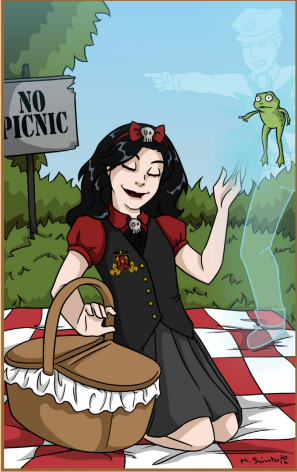
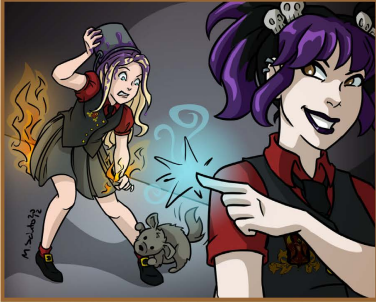
Yeah, I know that’s Circe, but it’s a witch being a dick to someone. Still counts.
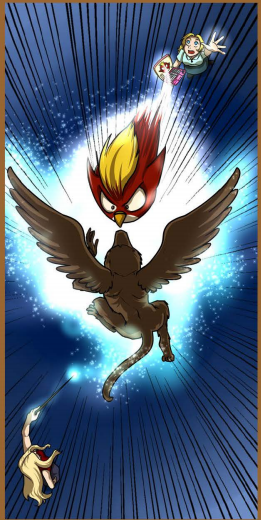
There’s nothing wrong with this one. I just wanted to share it with you all.
Next: Magic.
Magic
Original SA post
Witch Girls Adventures: Respelled: Part 6: Magic
WGAR posted:
The magic system for Witch Girls Adventure is unique. It's also something we're really proud of. Still it had some issues and fans for some reason really wanted a more.... Interesting way to show spell failure.
Most of the basic rules in the magic system are the same. Non-contested spell rolls are now a Hard difficulty roll instead of an Easy one if you go by the first mention of the rule. The charts are copy-pasted from the core. Characters can regain zap both at a rate of the max of their Magic die for every full night’s rest, or one for every not full night of rest. Starting characters get a signature spell for every 3 ranks they have in a magic type. (And the example implies that they must be of that school of magic.) As the opening blurb implies, there is also a mechanic for when spells fail now. It’s basically Paradox from Mage .
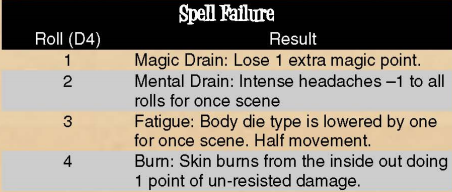
I’m just going to post the blurb for it because I can’t wrap my head around it.
WGAR posted:
A spell can fail in many ways. If the Caster rolls a 1 on their Casting roll Die, If they don't make the easy casting roll or they roll less than a targets resist magic.
Regardless a failure is a failure and one of four things happen (Roll a D4)
If there if anything good to be said about spell failure it is if you roll a 3 or 4 you can't roll them again till their scene of duration is overt. Instead roll a D4 on a 1 or 2 it's magic drain on a 3-4 it's the Burn.
I spent several minutes trying to write an explanation for why I think this mechanic is weird for this game. (It runs counter to the “consequences = not fun” philosophy, there’s nothing in-verse that makes magic something unnatural or fails for non-comedic reasons or that young witches have nothing but near complete control over what magic they know, this isn’t a universe where turning people into things is a risky venture and has the potential to fuck up reality… And what are the odds this will even come up? It seems like the system is trying its best to make sure people don’t fail rolls.) But then I remember what kind of writer I’m dealing with and realize that trying to figure it out is probably pointless.
Spell Augmentations are now limited based on the type of spell being cast, increase the cost of a spell by different amounts, and add penalties to the casting roll. (Usually by 1 or 2 points.) The book encourages DMs and players to come up with their own, but provides some examples.
Alter Resistance: Can change the attribute used to resist the spell from a choice of either Body, Mind, or Will. It may also add a +3 to the target number needed to resist? The wording is weird.
WGAR posted:
Body, Will and Mind are the available alternative resistance making the resistance roll 3+ the maximum attribute roll for that attribute.
It only costs a zap and a -1 Casting to do this and can be used for everything.
Alter Thought: Changes the mind of a person transformed so that they think they’re that thing. In the case of zombies, it makes them forget their old lives.
Multi Effect: Does 2 or more effects to the same target. The example given is a “fire-frost ball”.
Permanente: [sic?] Makes a spell permanent until the caster decides to dispel it. Can’t be used with healing and attack spells.
Program: Gives a summoned entity a set of tasks to perform until it is either dismissed or destroyed. Has nothing to do with Cybermancy.
Pushed: Increases the MTR of a spell’s duration, damage, range, range, or size by 1.
Set: The spell only goes off if certain conditions are met.
Trap: Put a spell on a place or a thing, and it triggers if someone enters or uses it.
Ward: A Protection spell stays on a person until it’s hit by the thing it’s protecting from… I guess? This is another one with awkward wording.
WGAR posted:
The protection spell stays on the person its cast upon till it's actually used/activated by damage or whatever the ward is protecting against. Activated it lasts for its duration then vanishes.
Zap-less: A misnomer since it only lowers the cost of a spell by one and does not work if it will lower it to 0. This is at the cost of a -2 to the roll.
The rest of the chapter is just a list of spell effects for each school of magic. Gone are the actual spell examples. In place of the spells is a list similar to the ones I made in my last write-up to get out of having to write out every single spell description.
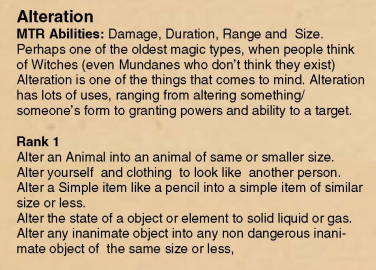
Yeah, this chapter is the height of
 . I wonder if Harris read my write-up and one of the few things he took from it was "just making a list of spell effects is faster".
. I wonder if Harris read my write-up and one of the few things he took from it was "just making a list of spell effects is faster".
Anyway, unlike the old book, there are examples that go up to rank 9 now; no longer leaving everything above Rank 6 to be world-destroying mysteries. I’m only going to list a couple from each list. If there’s only one, then that is probably the only effect listed for that rank.
Alteration:
Rank 1: Look at the picture.
Rank 2: Turn a person into another person, remove limbs and create deformities in animals, turn an animal into an object of smaller size and vice versa, give minor physical boosts, and make a barrage of arrows a bunch of useless items. (Doesn’t say if spell-loaded ones apply.)
Rank 3: Turn a person into an animal of the same size or smaller and vice versa, meld two things together, and turn an item into a more complex one (e.g. a book into a computer).
Rank 4: Turn a person or an animal into another one larger than them or a Rank 1-3 monster, grant up to two non-Magic attribute bonuses, and turn a person into an object of similar or smaller size.
Rank 5: Turn animals and people into rank 4-5 monsters, turn objects into rank 1-3 monsters, turn people into objects larger than them, and do damage with your Alteration spells.
Rank 6: Turn animals and people into Rank 6 monsters and objects into Rank 4-5 monsters.
Rank 7: Instantly destroy a target, and turn images of things into real objects.
Rank 8: Can turn targets into beings “existing only in story”.
Conjuration:
Rank 1: Create a handful of food, create a fragile wrapping (like paper) around an object, create smoke, and create palm-sized items worth 1-2 Wealth.
Rank 2: Create a full meal, a 3-4 Wealth harmless mundane object, small hand-sized animals, and uncreate conjured objects.
Rank 3: Can create a Guardian, harmless mundane objects worth 5-6 Wealth, objects powered by electricity, and metallic or stone binding around an object.
Rank 4: Create multiple mundane items at once, a temporary Rank 3-4 monster or Imaginary, clones, and stuff that does damage on contact.
Rank 5: Create a Rank 5 monster, a copy of an enchanted item, or stuff within targets. (Summon frogs in someone’s stomach, I guess.)
Rank 6: Create Rank 6 monsters, “light stuff”, copies of enchanted items, and complex structures.
Rank 7: Create a dose of a potion, multiple rank 1-3 monsters, complex landscapes and lifeforms, and clones of historical figures.
Rank 8: Create
Rank 9: Create small pocket dimensions and clones of fictional characters.
Curse:
Rank 1: Create minor blemishes like acne and warts, bad hair days, make people speak gibberish, and force people to reroll rolls.
Rank 2: Cause machines to malfunction, minor physical problems like “bad gas of sneezing”, grant a bonus or penalty of 1 to other’s rolls.
Rank 3: Can cause non-lethal diseases, increase damage on attacks, and create magical charms that give +1 to Wealth and rolls.
Rank 4: Alter a person’s finances, increase a person’s Reflex, and make sure a person who is needed is nearby.
Rank 5: Completely destroy an inanimate object, cause a target to come back as a ghost upon death, and directly damage a target.
Rank 6: Control the luck of multiple targets, “curse the target into an animal for half-normal duration”, and cause a person to instantly die.
Rank 7: Curse an entire party of enemies, curse an area or place, and turn a person into a vampire or shapeshifter.
Rank 8: Curse someone and all of their family members at the same time, alter a person’s past, and alter reality to change the outcome of a personal event.
Rank 9: Alter reality to change the future of an area.
Cybermancy:
Rank 1: Copy files from one computer to another, get an internet connection anywhere, and place spells on emails. Basically anything you can do manually with a computer, but refuse to do it that way because using your hands is for mundanes.
Rank 2: Use magic to augment hacking attempts, instantly create a computer program, phone app, or virus with your mind, create holograms, shoot electromagnetic pulses, and control multiple devices at once.
Rank 3: Make electronics explode, make sapient AI, create a firewall that blocks all mundane malware ever, download information onto non-electronic objects, and travel along networks as data.
Rank 4: Make a sapient AI physical as a “ball-like companion”, download information to your mind, and create a holographic 3D clone of yourself.
Rank 5: Download someone or something onto an electronic device, and make random illusions.
Rank 6: Bring digital characters to life as hard light constructs, turn illusions solid.
Rank 7: Download people and things into active apps and programs and teleport through electronic screens.
Rank 8: Create digital clones of yourself that will take over upon your death.
Rank 9: Create an alternate reality that can be traveled to.
Divination:
Rank 1: Give a nebulous bonus to Mind skill rolls, sense danger or lies, and see magic.
Rank 2: Prevent magical scrying, make magical energy visible, find items, and can scry up to however many ranks of Divination you have in miles.
Rank 3: Determine the abilities, skills, and powers of a target, look into the recent past of a target, make those scrying on them show incorrect images, and gain temporary ranks in skills they don’t have.
Rank 4: Can see the near future of a target, can cast spells on scrying targets, know the weaknesses of a target, and look into the far past fo a target.
Rank 5: Scry anywhere on a continent, can see 1 decade per MTR into the past and future, and temporarily give targets skills they don't have.
Rank 6: Scry from anywhere on the planet, can see a century per MTR into the past or future, and "the Casters for duration can gain skills they don't have as needed".
Rank 7: Scry from anywhere in their current reality, and can see a millennia per MTR into the past or future.
Rank 8: Can scry "anywhere".
Rank 9: Can scry into different timelines.
Elementalism:
Rank 1: Detect elements "at range", create small amounts of water and fire, produce fog or drizzle, talk to plants and animals, and change temperatures by 20 degrees.
Rank 2: Cause minor changes in elements, fly on a broom, change plant growth rates, and slightly alter the weather.
Rank 3: Change weather "for the better", cause damage with air or earth, control animals, and shape the different elements.
Rank 4: Change weather "for the worse", make it rain small animals and other "rare" occurrences, hit targets with lightning, and evolve animals and plants.
Rank 5: Control electromagnetism and devolve humanoid beings (including witches and other otherkin).
Rank 6: Control gravity and attack with electromagnetism.
Rank 7: Change people into animals and vice versa and attack wtih gravity. (So what happens if you increase the gravity in a room to lethal levels with the Rank 6 version? Does it just not kill everyone?)
Rank 8: Create and attack with radiation.
Rank 9: Damage multiple targets in a nebulous radius with radiation, electromagnetism, and gravity.
More magic later.
More Magic
Original SA post
Witch Girls Adventures: Respelled: Part 7: More Magic
Here is the rest of the thrilling spell effects lists. As you can probably tell, this entire chapter is low effort stream-of-consciousness gibberish that only exists to get words on pages.
 I don’t think there’s anything I can do to make it any more interesting. I wish I could just post pictures of the pages. It really just speaks for itself.
I don’t think there’s anything I can do to make it any more interesting. I wish I could just post pictures of the pages. It really just speaks for itself.
Healing:
Rank 1: Clean and/or sanitize someone, heal 1 HP per rank, repair a simple object with no moving or electrical parts, purify food and water, and stabilize targets.
Rank 2: Heal 2 HP per rank, repair mechanical objects, remove the effects of poisons, diseases, and mental illnesses for a time, and make a person "looks their best possible self".
Rank 3: Illuminate and repel undead creatures with pure light, heal 5 HP per rank, repair electrical objects, completely cure mundane diseases and poisons, and restore transformed people and animals.
Rank 4: Regrow limbs and organs, heal 10 HP per rank, repair minor magical items, completely cure magical diseases and poisons, and revive people who have recently died from electrocution or drowning.
Rank 5: Fire a beam of light that damages undead and shadow creatures, heal 20 HP per rank, remove mind control effects, and repair "powerful" magical items.
Rank 6: Make people immune to mundane poisons, damage multiple undead and shadow creatures, and revive people who have recently died from spells.
Rank 7: Grant full immunity to mundane diseases and revive people who have recently died from mundane causes.
Rank 8: Make people completely immune to magical maladies and full heal the dead instead of just stabilizing them at 1 Life.
Rank 9: Grant eternal youth and revive dead people while curing them of whatever killed them.
Illusion:
Rank 1: Can create annoying auditory, olfactory, and visual illusions, can make sounds and smells appear to come from somewhere else.
Rank 2: Create a single "realistic" visual illusion, continuous and realistic sounds, smells, and tastes, and destroy illusions and "illusion like" creations.
Rank 3: Create a small illusion that affects two senses, make illusions that are indistinguishable from their real counterparts and make them move, and turn someone invisible to one sense.
Rank 4: Create illusions that affect multiple senses, people and animals that act like real ones on their own, make multiple people invisible to a single sense, and create illusionary wounds that do damage.
Rank 5: Create multiple illusions, magical and "special senses" (e.g. infrared) ones, and ones that affect all of the non-magical senses.
Rank 6: Can remove a single sense from a target, place illusions on an area, project images into a target's mind, and make an area or multiple people invisible.
Rank 7: Create illusions of time changing, that can do damage, and can be solid for half of their duration.
Rank 8: Create illusions that are solid.
Rank 9: Create illusions over a large area as well as illusionary worlds "a target's mind".
Mentalism:
Rank 1: Lower or raise the next skill roll of a target by one, can find minds within a range, levitate up to 10 pounds per rank, raise their Mind die by 1 per rank, and instantly learn a language.
Rank 2: Levitate items up to 20 pounds per rank, "Non Physical Mentalism effect spirits", block mind effecting abilities and magic, fly at 25 mph per rank, make targets sleep or wake up, and read surface thoughts. (What does flying have to do with Mentalism? Is it like levitating? If so, then based on the other abilities, that shouldn't be possible at this rank.)
Rank 3: Levitate objects up to 50 pounds per rank, read someone's mind to know what they did that day, push objects up to 5 feet per rank, make targets do anything that doesn't harm them or is against their moral code, and remove the effect of a psychic or Mentalism effect.
Rank 4: Alter people's minds when they're awake or dreaming, make people do things that go against their morals, change a person's personality, "Levitate, Push and relate movement powers now affects maximum MTR targets", and link two minds together.
Rank 5: Switch two people's minds, astrally project, and erase a person's mind for a "standard duration".
Rank 6: Alter or erase everyone within MTR range's thoughts, levitate up to 100 pounds per rank and do damage, make people hurt themselves when they're mind controlled, and completely change a person's personality, memories, and skills.
Rank 7: Direct mental attacks do damage, and the caster can send a person's mind into the spirit world.
Rank 8: Can use Mentalism abilities on minds in the spirit world.
Rank 9: Can levitate up to 1,000 pounds per rank.
Necromancy:
Rank 1: Make open wounds heal at half the normal rate, play dead, damage spirits and shadow creatures for 1 damage per rank, prevent spirits from going into an area, and see and speak to spirits.
Rank 2: Damage spirits for 2 damage per rank, call the spirits of someone whose name they know, raise animals as zombies, and send spirits to the afterlife.
Rank 3: Raise people as zombies, make spirits summoned answer all questions truthfully, trap spirits in items, and turn oneself into a spirit.
Rank 4: Can make spirits appear in the real world, can suck out people's lifeforce, fire a bolt of shadow that does standard damage, and make spirits do things that go against their moral code.
Rank 5: All spirits and undead can be made to hurt themselves without the chance to resist, spirits and undead can be destroyed with a single spell, characters can possess dead bodies and raise them as zombies, and can pull people's spirits out of their bodies, turning them into ghosts.
Rank 6: Characters can strike a living target dead with a spell while turning their body into dust or severing their soul, can turn people into vampires, and zombies created have a +1 to Body, a point of armor, and normal speed.
Rank 7: Can turn vampires human and summon Rank 5-6 shadow creatures.
Rank 8: Can turn targets into a nebulous creature of shadow that can only be destroyed by pure light.
Rank 9: Characters can completely destroy a target's spirit.
Offense:
Rank 1: Stagger targets, do 2 points of damage, knock things out of character's hands, and remove a point of armor.
Rank 2: Do standard MTR damage, make inanimate mundane objects with less than 5 HP explode and damage everyone around them.
Rank 3: "Spells that do one or two points per offense rank can be made either unstoppable (always doing one point of damageor do damage to ghosts, spirits and shadow stuff creatures", crush targets, and give -1 to a target's Body.
Rank 4: Drain a target of one zap, give -1 to all rolls per rank in exchange for half damage... or something to that effect.
Rank 5: Can drain 2 points of zap, "spells can do half damage but continue doing damage once a combat round for 1 round per rank of Offense. The effect causes the target to be obliterated and die die."
Rank 6: Can drain 3 points of zap, "spells that do damage can be made to do half damage each round for the spells duration".
Rank 7: Link four spells together and alter Offense spells to be resisted by Body.
Rank 8: make a spell do double damage at the cost of 2 zap.
Rank 9: Make spells do triple damage.
Rank 10: Blow up the world. This isn't on the list, but it is mentioned at the top of the chapter.
Protection:
Rank 1: Double the HP of an inanimate object, grant a target a point of armor, Resist Magic, or willpower, which doesn't exist.
Rank 2: Increase armor to MTR defense, "attacks up to 2 points per rank pf Protection can be reflected back at the attacker".
Rank 3: Give 1 person "per up to the Protection maximum MTR target" armor, reflect spells back at the caster, and "the effect causes people not to notice what's going on in the area or even noticing the area is there."
Rank 4: Put up a 5 by 5 foot per rank barrier and put different effects on it.
Rank 5: Put up a 5 by 5 foot per rank barrier that reflects attacks.
Rank 6: Create a nearly unbreakable shield with 100 life points and standard defense around the caster that makes them immune to pretty much everything for a minute.
Rank 7: Place up to 4 effects on a single shield. "Unbreakable Shield Defenses is now standard duration."
Rank 8: Place up to 5 effects on a single shield. Characters can also make themselves immune to all physical damage.
Rank 9: "Cast a spell rendering immune to all but one common type of attack".
(Jesus, what a terrible list…)
Time and Space:
Rank 1: Warp space inside a container so that it's bigger on the inside, reduce the time it takes to travel somewhere by half, see a minute into the past per rank.
Rank 2: Perform an extra action in a combat round by stopping time and get a +5 bonus to do it, perform skills in half the time, double the distance between two points, and see up to an hour into the past.
Rank 3: See up to a day into the past, teleport within MTR range, turn invisible (by stepping out of time and space), and shrink or flatten yourself.
Rank 4: See up to a month into the past (or a day depending on which sentence you go by); teleport with "extreme" MTR range; and shrink, flatten, and turn other people invisible.
Rank 5: See up to a year into the past (or a month depending on yadda yadda yadda); teleport to any place you have been to; teleport multiple people at a time.
Rank 6: See up to a decade into the past, time travel up to a day either forwards or backwards, make a time travel portal, make a singularity, and teleport to other dimensions.
Ranks 7 through 9 (and presumably 10): "Unknown or Erased fro existence [sic]" because Harris got bored and wanted to get this chapter done.
Part of nearly $9,000 went into writing this.
There isn’t even any new pictures that I can show you. Fuck.
Next: Equipment, and hopefully something more interesting
Equipment
Original SA post
Witch Girls Adventures: Respelled: Part 8: Equipment
The equipment chapter starts off with an explanation of the Wealth stat. It works in pretty much the same ways as the Allowance stat: Your savings determines your starting pool of points to buy equipment with at creation (which does not carry over when the game starts), while you get however many points of wealth you have a week in-verse.
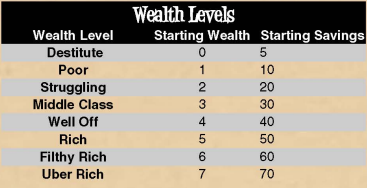
Wealth is directly tied to a character’s lifestyle, which is explained in fluff charts that tell the players that if they’re playing an orphan who lives on the streets, their character probably doesn’t have a winter home in Cancun, among other things.
New to the equipment system is “Add-Ons”: properties that can be put on items to customize them while increasing their cost, in place of a list of individual items. The amount of add-on points a character can have on something is limited by their age. Standard starting characters can put a maximum of 15 points worth of add-ons onto an item.
The rest of the chapter, as you’ve probably already guessed, is a list of the different categories of items and the various add-ons that go on them. Bah…
Basic Supplies: Regular clothes, electronics, and a month’s worth hobby supplies/manga. Doesn’t have any add-ons and is bought at a rate of 3 pieces to 1 point. The only interesting bits is that the list of clothes includes an entry for a “formal Immortal kilt”, and you can buy up to 5 video game systems for 2 points.
Armor: Your basic suits of armor, from leather to “moon metal”. Comes with a note mentioning that it’s considered rude to wear armor in the magical world. Add-ons include:
-
Custom:
Reflex and Skill roll penalties are 1 less.
-
Metamorphic:
Turns the armor into a piece of jewelry when not in use. Costs a “power point” to activate. What are those? Well, based on some stuff later in the chapter, I’m going to guess it is a remnant from the time when there were rules in the works for playing non-witches. I’m assuming it was the non-witch version of zap.
-
Used:
Increases Reflex and Skill penalties by 1.
- Viva: +2 Life points and +1 to resist poison and diseases for… reasons.
Clothing: Regular clothes that might have enchantments on them. Tops and bottoms cost 1 while most accessories cost 2 for some reason. Add-ons include:
-
Armor:
Adds 2 points of armor.
-
Changing:
Instantly clean and change the colors of the item for 1 zap.
-
Flight:
Spend a zap to fly up to 50 mph. Can be put on shoes and backpacks.
-
Speed:
Gives the item a rank of Hyper Movement, which doesn’t exist, in return for a power point.
- Holding and Stasis: Turns backpacks, purses, and hats into bags/hats of holding. Costs 7 points altogether.
Electronics: Electronics that can have add-ons on them. Chart includes listings for generic “mini”, “small”, and “large” gadgets. The former two cost more than the latter.
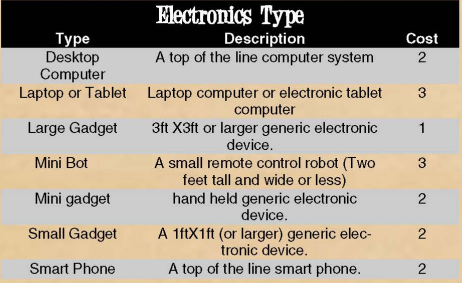
Add-ons include:
-
A.I.
- Makes the item a sapient entity with D6 stats, a combat action, 19 skill points (with 4 reserved for the Computer skill), and no “Power attribute” skills, which I guess was the non-witch version of the Magic attribute.
-
Foci:
Lets the character cast spells with the item. Gives a -1 to zap costs and lets Foci add-ons be applied to the item.
-
Hacker Defense
and
Offense
: Penalties and bonuses (-2 and +2) against and for hacking, respectively. Defense can be taken multiple times. The Offense blurb implies that it used to be called “High Tech”.
-
Holographic Read-Out:
Makes holograms. “That picture is takes an ease senses roll to see through and detect as not real.”
-
Monster Knowledge:
Turns the device into a pokedex that gets regular updates. +4 to Cyrptozoology and History rolls.
-
Peripheral Support:
Lets the device control nearby cameras, printers, monitors, scanners, whatever. +1 to hacking rolls.
- Power Detection: Turns the device into a Dragonball Z style scanner. Insert an old power level joke here.
Eyewear: Glasses and goggles. Nearly all of the add-ons involve adding the ability to see different things like magic, ghosts, in the dark, and incoming punches (to give an excuse for some Reflex bonuses).
Foci: The term “foci” is now used as a catch-all term for anything that is used to cast spells, including wands. All foci reduce the zap cost of spells by 1, can levitate a pound of stuff up to 20 feet at the cost of a zap per minute, ignore 5 points of damage, and have 10 life points. Characters can only own one primary foci. Along with stuff that have the “Foci” add-on available, they can choose between either a wand, a cane, a staff, or an umbrella. Also…
WGAR posted:
Characters with the magic ability cannot purchase Foci.
The add-ons list is mostly just the custom wand stuff from the core chopped up. The only thing that the four main types of foci are required to have now is a Material. (Which are halfway through the list due to it being in alphabetical order.) Add-ons include:
-
Aptitude:
The crystal tip part of the custom wand section from the core. Which makes no sense if you’re using a smart phone or laptop as your foci. +1 to Casting of two specific magic types.
-
Bane:
+1 to Casting against a specific monster, including mundanes and mortals. No, that’s not a typo. There’s a difference between the two that you’ll learn about later. I learned that while I was writing this post and now I’m wondering if Harris just decided on that when this part was being written. I probably used one or the other interchangeably when I shouldn’t have. Whatever.
-
Change:
Turn the foci into a normal item that is under a foot long.
-
Focus:
Increase one of the aspects of a spell so that it’s one MTR higher.
-
Light:
Use the tip of the foci as a flashlight for a zap a minute.
-
Lighter:
Same as the above, except produces either a small flame or a 2 foot jet (that does 1 damage) for free. The blurb makes it out to be an attack, but it’s definitely in here for all of the witches who like to turn people into cigarettes and smoke them. Can only be used with wands and canes. (I’m a little surprised that I haven’t come across an NPC who vapes and does that. It’s probably an image thing. Not as erotic or whatever.)
-
Magi-Lock:
Shocks (2 damage) anyone who tries to use the foci. Says it can be used for any type of foci, but the blurb specifically mentions wands and staffs.
-
Material:
Along with all of the different wand coatings from the core, with mentions that ebony wood is the most common and unicorn horns are rare, we have elder wood (immune to Elementalism spells and gets bonus against them), haloium (bonuses to Healing spells and can’t be used by wicked characters), moon metal (makes you faster under a full moon and gives bonuses to Alteration), night metal (growls when waved, can’t be used by heroic characters, and gives bonuses to Necromancy), and zombie bones (AKA human bones, gives bonuses against the undead).
-
Self-Powered:
The foci runs under spell or battery power and doesn’t require spending a zap point to use it.
- Used: Has only 8 life points and does a point of damage to the user if a spell fails.
Instruments: Musical instruments for characters who study music or use music when casting magic. These can have the Foci add-on applied to them and the item chart includes entries for drum sets and pianos. I like this section only because it gives me a host of amusing mental images of witches casting spells with gongs, keytars, and theremin .
The image also includes an axe guitar, because of course it does.
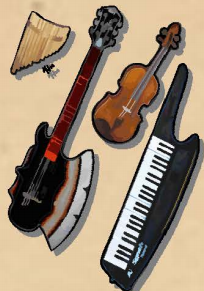
( One of the first images that pop up in Google Image Search for “axe guitar”. ..)
Add-ons include:
-
Charmer:
+1 to Social skills when played.
-
Double Duty:
The instrument is a keytar or any other combination of two instruments. Has no requirements or restrictions on the kind of instruments you can use. So the sky’s the limit on what you can make with this one.
-
Floater:
The instrument can float and stay within 20 feet of the owner. This is the start of the mention of several things requiring a trait called “High Tech for Mortals”.
-
Ka-bong:
Allows you to beat someone with the instrument (2 points of damage) without destroying it.
-
Light Shower:
The instrument produces controlled sprays and waves of light when used. +1 to Instrument rolls when in front of an audience.
-
Masterpiece:
The instrument was made by a master craftsman. +2 to Instrument rolls.
-
Self-Playing:
Gives the instrument a skill roll of D8 +2 (+3 if it has the Masterpiece add-on) that it can use to play itself.
- Sidekick: The instrument is alive, has a Music skill (which doesn’t exist) of 4, and 8 points worth of mundane skills.
Jewelry: There’s no longer a limit on how many pieces of jewelry you can have. Tiaras and crowns are an option if you want to play princess, and amulets/necklaces cost the same as a cello, a smart phone, and a desktop computer. Can have the Foci add-on applied to them. Other add-ons include:
-
Boost Attribute:
Gives +1 to a chosen attribute at the cost of 1 zap per hour.
-
Communication:
Spend a zap to send a telepathic message to another person with a piece of jewelry with this add-on.
-
Power-Points:
Gives the wearer +2 zap.
- Prep: Turns the item into that ring from the core that instantly gives you a shower, fresh clothes, a full stomach, and 8 hours of sleep at the cost of a zap point.
Magic Consumables: Includes makeup, candy, candles, and potions. All consumables cost no zap to use and have a D8+4 Casting roll to activate whatever power they have on them. Candles may or may not have to be eaten, however…

Add-ons include:
-
Duration:
Determines how long an effect that isn’t Healing or Energize last for. Can be from a single combat round (1 point) to a day (4 points).
-
Energize:
Restores 2 zap. “2 per rank up to three ranks can be purchased”.
-
Healing:
Same as Energize, except with life points.
-
Package:
Allows candy to come in a pack of 6 pieces. Costs 3 points.
- Tax: Has the same blurb as Energize. So who knows what this does.
Miscellaneous Items: Any magical bric-a-brac that doesn’t fall into any of the other categories. That is to say, books (including e-readers), hobby kits, and trinkets (items less than a foot tall and wide and weigh less than a pound), since that’s what the chart for this section has listed. Add-ons include:
-
Aligned:
An add-on for books that gives a +1 to Casting based on a specific alignment, be it Good, wicked, love, hate, humorous, or whatever.
-
Aura:
Lets a trinket give off a positive or negative aura (which pretty much translates to +1 or -1 to rolls) within 5 feet of it. The blurb mentions books that have it, even though this add-on can only be applied to trinkets.
-
Build Kit:
Determines just what exactly can be built with a Kit item. Kits can build up to 5 Wealth’s worth of either electronic, mechanical, medical, computer, potions, or magical items. Also gives a +1 to repair rolls for whatever type of object the kit builds.
-
Library:
Lets you replace a book in your possession with another that costs the same. Can only be used once a day. The amount of points spent determines how many books can be switched out at a time. (2 points for one, 3 for 2, and 4 for 3.) I’m not quite sure how this works. It doesn’t say anything about a library card or the books being magical in some way or where the damn things come from.
-
Stasis:
Keeps anything, items and creatures, locked inside a trinket alive and in perfect condition. Same as it does for clothing. Probably in this section explain all of the characters locking people inside objects.
- Trivial Magic: For a zap, the item performs any act of magic that would probably be classified as a cantrip in other systems and has no effect other than that “it’s really cool”. The example given is a pen that floats and dictates what you’re saying, ala Rita Skeeter.
Pets: This is just an expanded version of the Pets/Familiars section from the core. Many of the stat spreads for the different pets you can have are the same. There are some new types of pets you can have, however. These are aracsi (foot long and tall spiders with an ability called “Does Whatever A Spider Can”), lesser chimera (who can actually choose their abilities from a list), dragonlings (tiny dragons that can talk and don’t really see themselves as pets), horses, and generic reptiles. Fish have been removed from the list for some reason. Furballs (mice, gerbils, hamsters, hedgehogs, etc.) cannot be owned by mortals for some reason. None of the other animal types have that restriction. So while chinchillas and the like are verboten, you’re free to own a fucking lesser chimera even if you don't have a drop of magic in you.
Also, the picture for this section depicts the most fake looking unicorn ever.
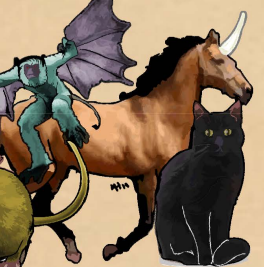
Add-ons include:
-
Alpha:
+2 to social rolls with animals of their type, and +1 with similar animals.
-
Beautiful:
+1 per rank (up to 3) to their Social die.
-
Familiar:
Allows the character and their pet to communicate telepathically and share zap and life points.
-
Good:
Can spend 2 zap to heal a single life point in someone else and anyone casting Necromancy and shadow spells are at a -1 to do so around them.
-
Shapeshifter:
The pet can turn into an animal that is the same size or smaller for 2 zap per minute of transformation time.
-
Wicked:
+1 to resist shadow and dark magic, and healing and light magic is at a -1 to cast when near them.
- Zombie: The pet only eats brains, is immune to psychic and mind attacks, and has a -2 to resist Necromancy spells.
Transports: Brooms, bikes, cars, scooters, motorcycles, flying umbrellas, flying surfboards, and other things used for transportation. Each has a different max speed and amount of life points listed. Add-ons include:
-
Aquatic:
Makes everything except regular bikes work under water. (Actually, a lot of stuff in this section can’t be applied to regular bikes.)
-
Cloaking:
Spend a zap to make the object blend into the nearby scenery for up to a minute. Everyone inside it also gets +2 Reflex and sight rolls to detect them are at a -1.
-
Flight:
Makes the item fly. If you’re getting a broom or a carpet and you don’t get this, you’re kind of dumb. Spend a zap to fly up to 50 mph per rank bought (2 for 1, max 3) for up to an hour. “"If the transport can fly, the adds to it's flight. speed"[sic]
-
Green:
Makes the vehicle environmentally friendly and travel twice as far without needing to refuel.
-
Jump Boost:
Do a sick 40 foot vertical and 100 foot horizontal jump when you hit full speed.
-
Life Support:
The inside of the vehicle is pressurized for high altitude or underwater travel and is always at the perfect temperature. (So what happens if you buy an aquatic vehicle without this?) Also gives a +1 against hot and cold attacks.
-
More Than Meets the Eye:
Turns the vehicle into a bracelet, credit card-sized piece of plastic, or a toy car when not in use for 1 zap.
- Safety First: Passengers take half damage from crashes.
Weapons: Generic weapons are divided up into various types which have different sets of life points, damage modifiers, and costs.
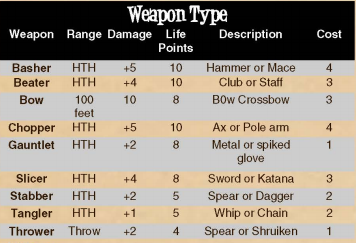
This is added on to your base damage, which is whatever your normal hand-to-hand damage is. Things like Hyper Strength, which doesn’t exist, also affect how much damage a character does. Weapons can be made into Foci. So your Punch Witch can have a set of magical brass knuckles to cast her spells with. Add-ons include:
-
Amulet:
Turns the weapon into an amulet and gives a -1 to anyone trying to figure out it’s a weapon in that form.
-
Elemental:
Pick an element from this chart and get the benefits from it. The weapon will also do damage of that element.
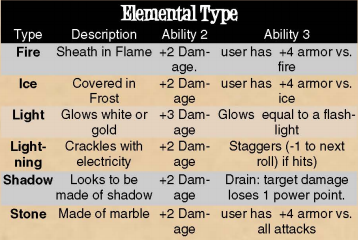
-
Energy:
Makes bows fire energy beams instead of actual arrows. Does +2 damage and can make the target fall unconscious for D4 minutes if they fail a Hard Body roll instead of doing damage.
-
Magic Bow:
The Archer niche from the Character chapter. So if you didn’t get it from that, you can get it here.
-
Oversized:
Wield a sword that is as large as you, ala Cloud from
Final Fantasy VII
. Requires at least a D8+1 Body or a rank in Hyper Strength, which doesn’t exist. Has +1 Armor, +10 Life, +2 to damage, and +1 to Scare rolls in combat. In addition, anyone damaged by the weapon has to make a Hard Body roll or get pushed back 10 feet.
-
Pack (of Ammo)
Provides 10 arrows for bows and turns one thrown weapon into 4. This add-on is required if you’re using a bow. Doesn’t say if it’s required if you just use energy arrows instead.
- Self-Powered: Is included on this list for some reason even though regular weapons don’t require zap to use.
Guns: The blurb emphasizes that guns may not be the best fit for your campaign, but witch hunters and quirky witches with a steampunk or zeerust bent use them. So the rules have to be in the book. Guns are divided up into three types: Pistols, Rifles, and Ray Guns. Rifles are the best choice, but the most expensive. (They cost as much as a muscle car. 8 points.) Ray guns can be used as foci. Add-ons include:
-
Ammo:
Pretty much the same as Pack (of Ammo). Required for pistols and rifles to work.
-
Autofire:
The gun can fire a D4 roll’s amount of times in an action, with a -1 to hit and damage after the first attack.
-
Blaster:
Pistols and rifles can fire plasma bolts instead of regular ammo. (Doesn’t say if you need to take ammo if you take this.)
- Hunter Rounds: A mortals only add-on, this allows for the purchase of specialty ammo, including silver bullets (+2 damage to werewolves), gold bullets (+2 damage to vampires (never heard that one before, but okay)), rock salt (somehow hurts spirits), and cold iron (+2 damage to fae, +1 damage to witches, even though the cold iron weakness is NEVER brought up in the rest of the rules as being a weakness witches have).
We’re done with this chapter. Have a terrible picture.
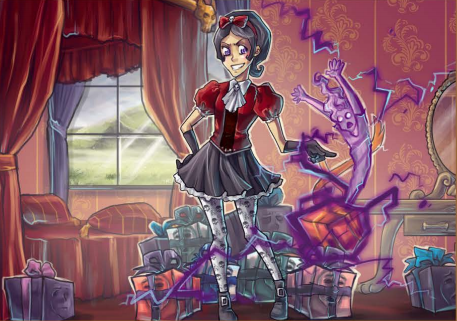
Next: The Appendix.
Pre-Generated Characters and Other Loose Ends
Original SA post
Witch Girls Adventures: Respelled: Part 9: Pre-Generated Characters and Other Loose Ends
The lone appendix in this book is just the dumping ground for gameplay rules that weren’t put up front for some reason. Along with some pre-generated PCs and their sheets. Along with the rules regarding actions, this is how much characters can lift…
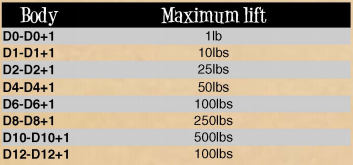
(Missing a zero on that last one...)
…and this is how fast they can go if you use the optional move speed rules.
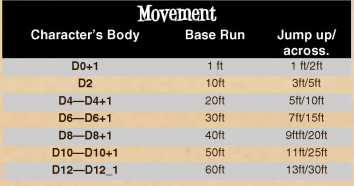
And now, some pre-generated characters. If you were sad about the lack of truly terrible art in this book, don’t worry. Soto did the portraits for these characters. And because they were obviously traced from poser models, they all have the same lovely dead-behind-the-eyes stare and arthritic hands.
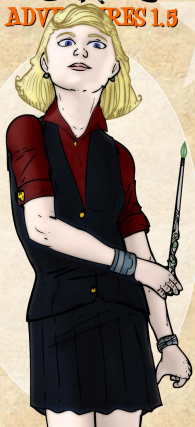
Ami Cutter
On the outside, Ami is an “overly dramatic” girl from a “good” magical family who is concerned with fitting in. On the inside, she feels the need for speed and wants to be a broom racer. They don’t give a reason for why she would want to hide this desire or why it would be in any way unacceptable. Probably has something to do with her family.
Her sheet describes her as being a middle class girl who is “human-shy and deadpan”. She has the Drama Queen and Flier talents, the Oracle heritage, and the Book-Worm and Broom Talker knacks. Nearly all of her skills have a +6 in them. (None of them have less than a +4.) In fact, she has a ridiculous amount of skill points for a starting character (24 Mundane and 35 Magical), and at least 4 of the points are unaccounted. One of which is the free rank in Acting she should have from the Drama Queen talent. Her magic and skill spread makes her out to be more of a monster hunter than an aspiring broom racer.
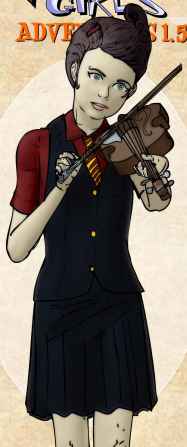
Angela Saint-John
Angela discovered magic through her love of music. As a result, she had an easier time adjusting to the magical world than most, and has come to love the adventure of it all. She meets every new challenge with grace, a smile, and a song.
Angela has the Outsider Savant niche and uses her Social die to cast spells. She has the Brave and Calm talents, the Melodious heritage, and the Magician and Naive knacks. She has a violin as her foci, which she’s tuned to give her a bonus to Mentalism spells. This allows her to do things like her signature spell, “Puppet”, a Mentalism 3 spell that lets her mind control people. 7 of her Mundane skill points (which include a lot of +5s) are unaccounted for, including the free rank of Focus she should have for having the Calm talent.
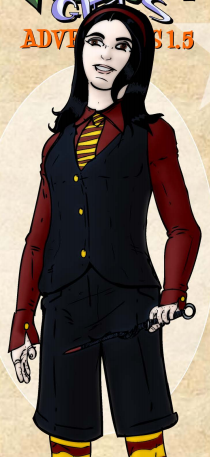
Jessica Chimere
Jessica fixates on the fact that she and her parents are from another dimension. They won’t tell her anything about the dead world they’re from for some reason, so she spends her time studying up on the multiverse. The only hints about her origins are that she has the Half-Immortal heritage and she uses chakrams as a weapon. Also, her picture creeps me out.
Jessica is a Gothique with the Eclectic niche. She has the Goody-Goody talent, but she also has the Instant Karma knack and her signature spell is an Alteration 3 spell that shrinks people. So you can imagine what she’s supposed to do in a lot of situations. She has the right amount of skill ranks, but she’s missing a free rank of Curse. She also has the Chubby knack, if you couldn't tell, along with the Urban talent.
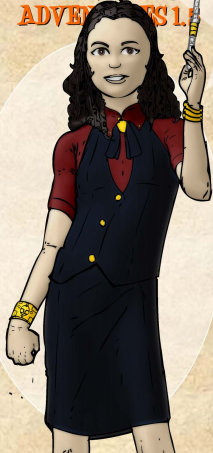
Laura Vivo
Laura’s divorced parents spoiled the shit out of her and always told her how beautiful and special she was. Yes, you guessed it, she has the Mary Sue talent. That’s pretty much it.
Laura is an Insider with the Strange Relations niche. She has the Eccentric talent along with the Mary Sue one, the Dreamer heritage, and the Lucky and Attitude: Scatterbrained knacks. 2 of her mundane skill points are unaccounted for.
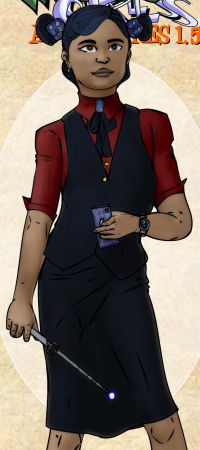
Nana Muraille
Remember when I mentioned that Harris had just got into Doctor Who when he wrote this? This character proves that. She is the former companion of “Professor Clue”, the main character of the in-verse TV show of the same name that turned out to be real. (Complete with a pulsing magical machine and a sharp wit.) She met him when she was fucking around with a program that could let her see into other dimensions, and accidentally summoned some sort of nasty. Since then, she’s been trying to find him again.
Nana is a Techie with the Cosplayer niche. She has the Geek and Witty talents, the Warper heritage, and the Big Bank, Wards, and Attitude: Curious and Short Attention Span knacks. Her signature spells are a Time and Space 2 spell that stops time and a Cybermancy 3 spell that lets her teleport through electrical currents. She has the right amount of mundane skill points and has an unaccounted for magical skill point.
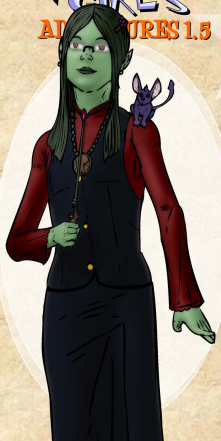
Rosie Flowers
Raised in a hippie commune in New York, Rosie is probably the sweetest witch you will ever meet, which runs counter to the typical stereotype of witches with Hag’s Syndrome being evil. Not that you can tell when every witch in this setting is some flavor of asshole. She loves the outdoors, her “shadow-glider” (and familiar) Mr. Chippers, and hates violence.
Rosie is a Rustic with the Demeter niche. One of her signature spells is an Alteration 3 spell that turns people into animals. So despite being the sweetest witch in the world, she will probably still turn you into an animal if you annoy her. (Her other signature spell, an Elementalism 2 spell called “Green Thumb”, isn’t explained.) She has the Rural and Trickster talents and the Ghost Magnet, Natural Telepath, Pacifist, and Flammable knacks. She’s also got an unaccounted for magical skill point.
And that’s it! The book is over! The only things left are a blank character sheet and advertisements for all of the other wonderful supplements you can buy for this game, including one for this very book.
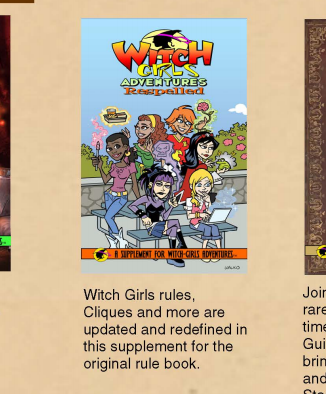
Next Book: The Official Guide to Coventry School for Girls , wherein Witch Girls goes back to its claimed roots, we learn about the best magic school in the multiverse, find out where some of the Shrinking Sorceress characters have been hiding, meet Diet Lucinda, and gawk at one of Harris’ self-inserts: the most inept immortal ever.